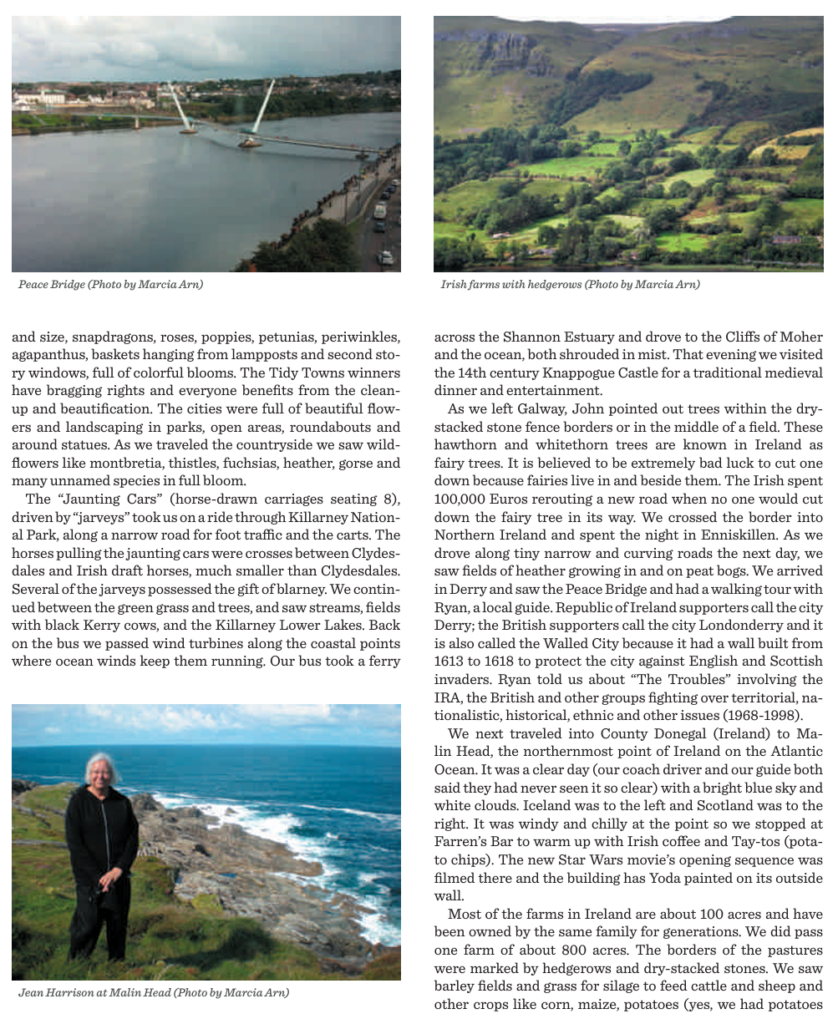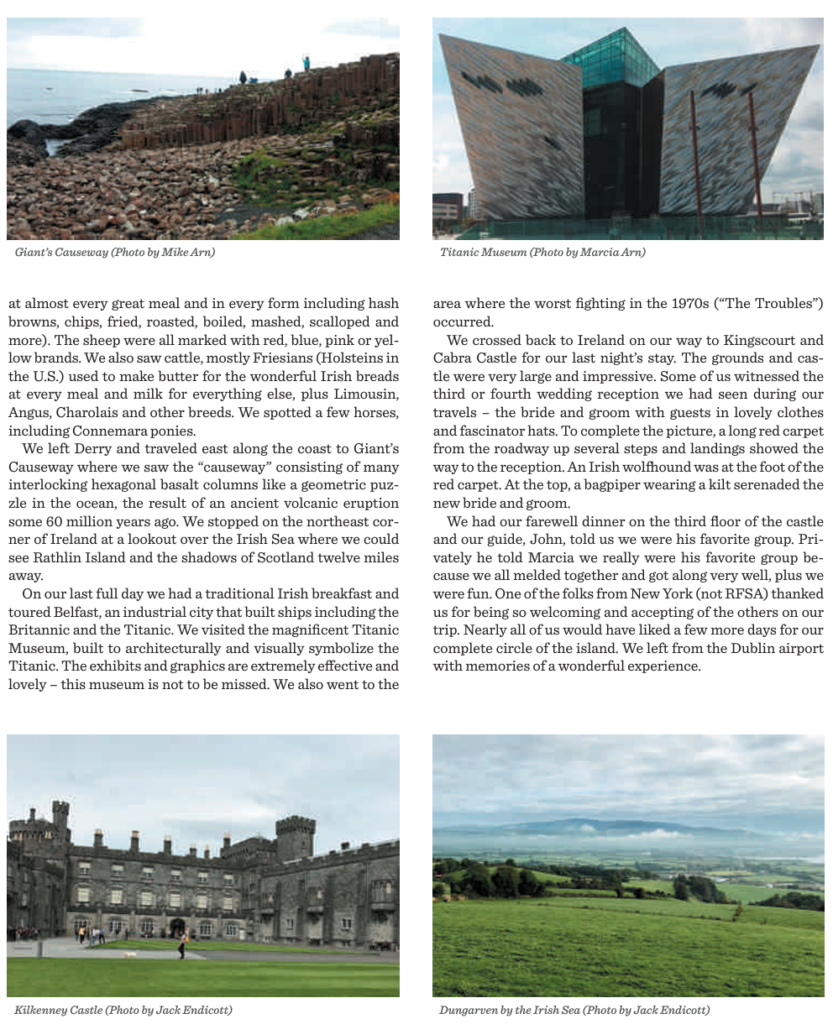Another traveler’s report:
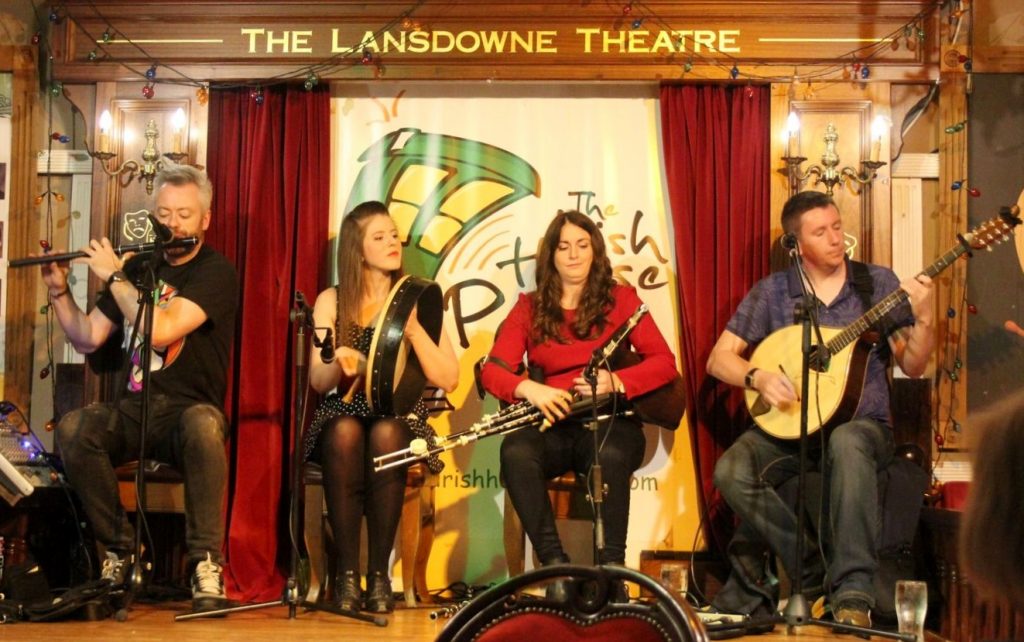
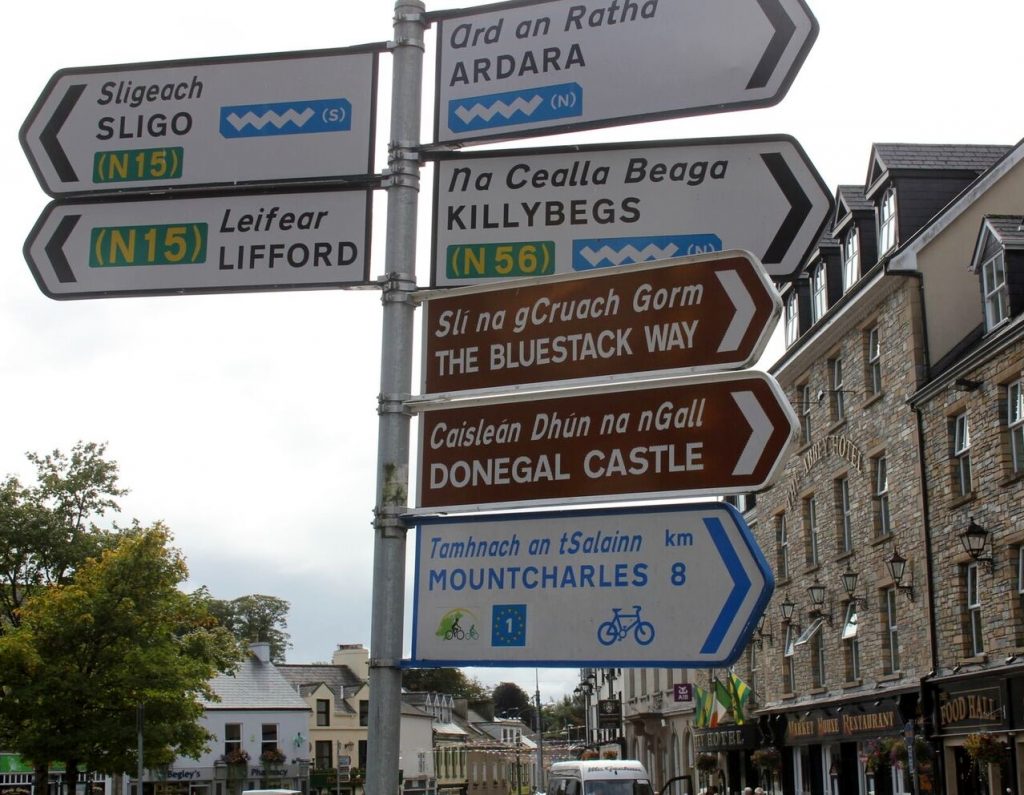
We arrived in Dublin a little after 10 am on Aug 23, met our tour director, John Hogan, and were taken to our hotel to leave our luggage there safely until rooms were ready. Besides our RFSA group of 23 members and guests, there were 17 other people with us, including a couple on their honeymoon! We were dropped off in the center of town to spend a few hours to explore on our own. Some went to nearby Trinity College, shopped, had lunch, went to museums or just walked around. Some of us made a stop at the National Gallery of Ireland, then walked down O’Connell Street as far as the General Post Office. We were picked up at 4 pm to check into our hotel rooms and a bit later went to a pub for dinner. The entertainment was the Irish House Party band, a group of four who played Irish instruments, Declan on the black flute, Rachel on the bodhran drum that is shaped like a big tambourine, held with one hand inside and hit quickly by a double headed stick with the other hand, and Tyra on the uilleann pipes, a strictly Irish instrument that sounds nicer than bagpipes, with two smallish bellows squeezed alternately under the elbows, pumping the air into the chanter (no mouth blowing) that she fingered for the different notes. This was the instrument played in the movie Braveheart, rather than bagpipes. Jerry, the lead vocalist, played the bouzouki, which is like a round guitar with a flat back. It may have originated in Greece as it is played in their traditional music. The music was interesting and fun, and Rachel also did Irish step dancing for us, as well as a brush (broom) dance. It was a great evening.
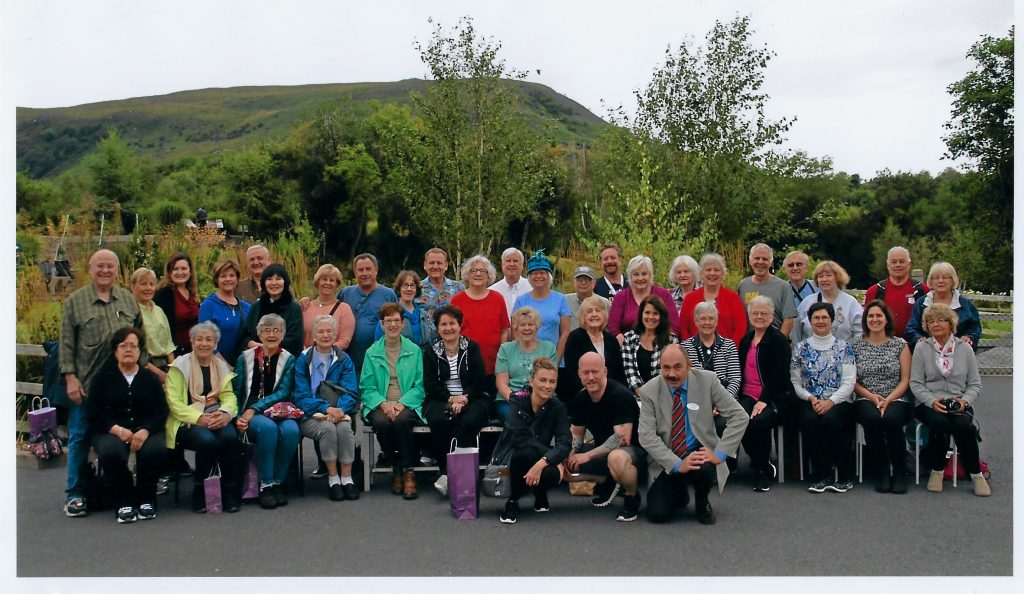
We discovered that buildings, including hotels, in Ireland are not air conditioned, so it was nice that it was pleasantly cool and we could open windows, which tipped in at the top and out at the bottom about 4 inches.
Information technology is a very big industry in Dublin and Ireland – there are many large companies there including from the USA. Pfizer and Apple are there. Ireland has workers, they speak English, and companies get a tax break. A great many of the people bicycle or walk to work in Dublin.
The next morning was a bus tour of Dublin with a local guide. We went into the older part of the city and stopped at some late 1700, early 1800 four story townhouses. The windows get shorter on each successive floor to give the illusion of height. The townhouses are historically protected and the outside cannot be changed, but the inside can be updated and remodeled, used mostly now as offices by tech companies. Some of the doors were painted different colors, which earlier helped the men coming home from the pubs to recognize which door was theirs.

Vikings first invaded Ireland around 800AD and built wooden buildings and walls. In 1169 the Anglo Normans invaded Ireland, put it under British rule, and stone buildings replaced the wooden structures. We drove by large Christ Church with connected Dublinia museum and passed part of the remaining old Dublin city wall that was originally built of wood and in 1240 of stone. On the Irish side of that wall was Fishamble St. down to River Liffey where the people who sold fish (fishmongers) lived at that time. The next stop was the beautiful St. Patrick’s Church, which was originally a Catholic Church erected in 1190, but after the Reformation it became Anglican/Church of England. There was a statue of Benjamin Lee Guinness in the courtyard, whose family were members and was a benefactor of the church who paid for many improvements in 1865. The Guinness family still attends there.
We drove passed the 21st century James Joyce Bridge twice, which is made to look like an open book and crosses the River Liffey that flows through Dublin, as well as the pedestrian Ha’ Penny and vehicle Father Mathew Bridges built in 1816, Rory O’More Bridge that replaced another one in 1869, O’Connell Bridge that was a 1880 reconstructed, widened and renamed version of Carlisle Bridge built in 1791-4, and 21st century bridges Samuel Beckett and Sean O’Casey. We also passed the Guinness Brewery built in the 1800s. To get a job there meant good wages, two pints of Guinness at the end of each day (they still do), two weeks of vacation and a pension. If they died, their wife got a pension for the rest of her life. People would encourage their daughters to go out, have a good time and find a man who worked at Guinness because they were worth as much dead as alive.
We next went in the 1,700+ acre public Phoenix Park, where we saw a hill that had been built up in a broad green field with a large cross on it. It had been made for Pope John Paul II’s 1979 visit where he conducted an outdoor mass on the hill to over one million people. The park also is home to a zoo famous for breeding lions, many sports fields, lakes, open areas, the home of the US Ambassador to Ireland, and the 1754 “Ireland White House”, the home of the President of the Republic of Ireland, currently Michael D. Higgins.
In town, driving down O’Connell Street, we saw several statues including the O’Connell statue with four large angels around the base that had bullet holes in them from the Easter uprising in 1916.
At 12:30 the bus dropped off those who wanted to explore more of Dublin and some went back to the hotel. It was free time again, so people went different places. Some went to the Trinity College Library, considered an Ireland treasure, which has a treasure trove of manuscripts and also has a section that holds the Book of Kells, a lavishly decorated text that contains the four Gospels of the New Testament with texts and tables believed to have been created c.800 AD. The old library is in the Long Room which houses 200,000 of the library’s oldest books and is breathtaking to walk through.
Some of us went to the Museum of History and Archaeology where there were ancient artifacts, a 50’ long dugout logboat and four bog bodies. Those were human bodies that had been found in bogs that had preserved them. After the museum, three off us walked several blocks to Christ Church and Dublinia, but didn’t have enough time to tour them, so walked down to the city wall and gate, went through the gate and up to the grounds of St. Audoen’s Church. From there we walked back towards town, seeing old boot scrapers by front doors of buildings, stopped at the Dublin Castle courtyard, then hurried back to the bus stop.
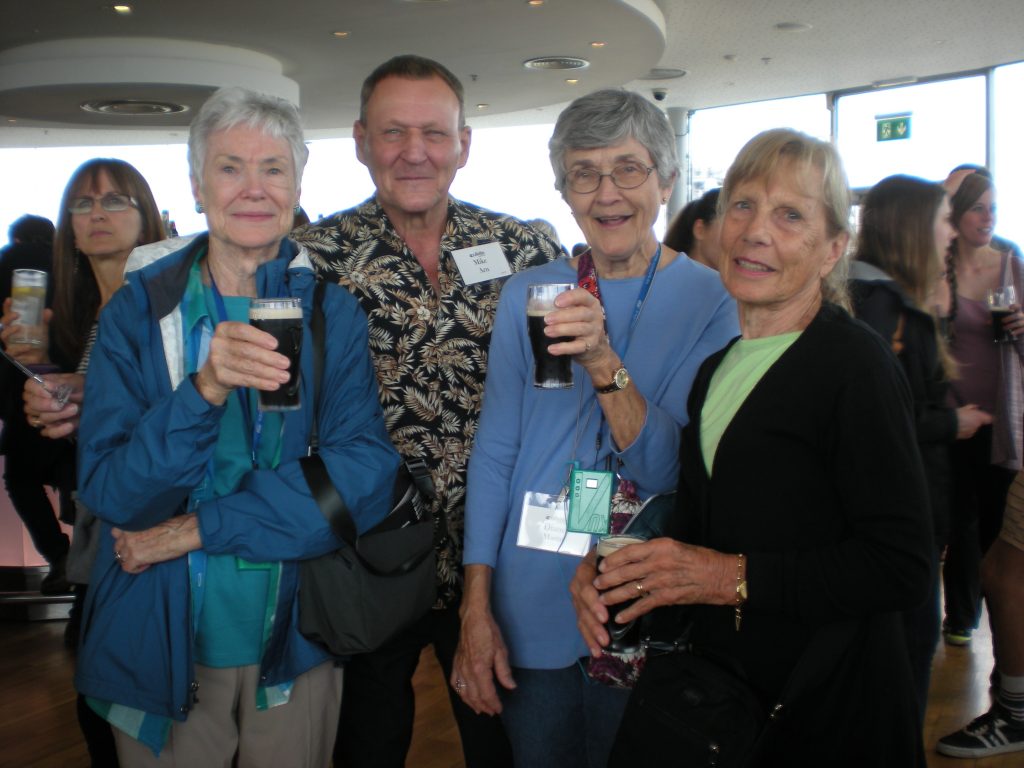
The bus took us all to the Guinness Storehouse for a tour and the Guinness story. In 1759 Arthur Guinness signed a 9,000 year lease on a dilapidated brewery at St. James’s Gate, paying £40 per year. They now own the business, but still have the lease in a safe. We did not see the actual process of making the beer, but learned about it, saw barrels, some pictures and quite a presentation of old advertising items. Everyone was offered a free sample of Guinness beer and at the end we went to the 7th floor Gravity Bar where we had a ticket for a free drink, as well as an almost 360° view of Dublin.
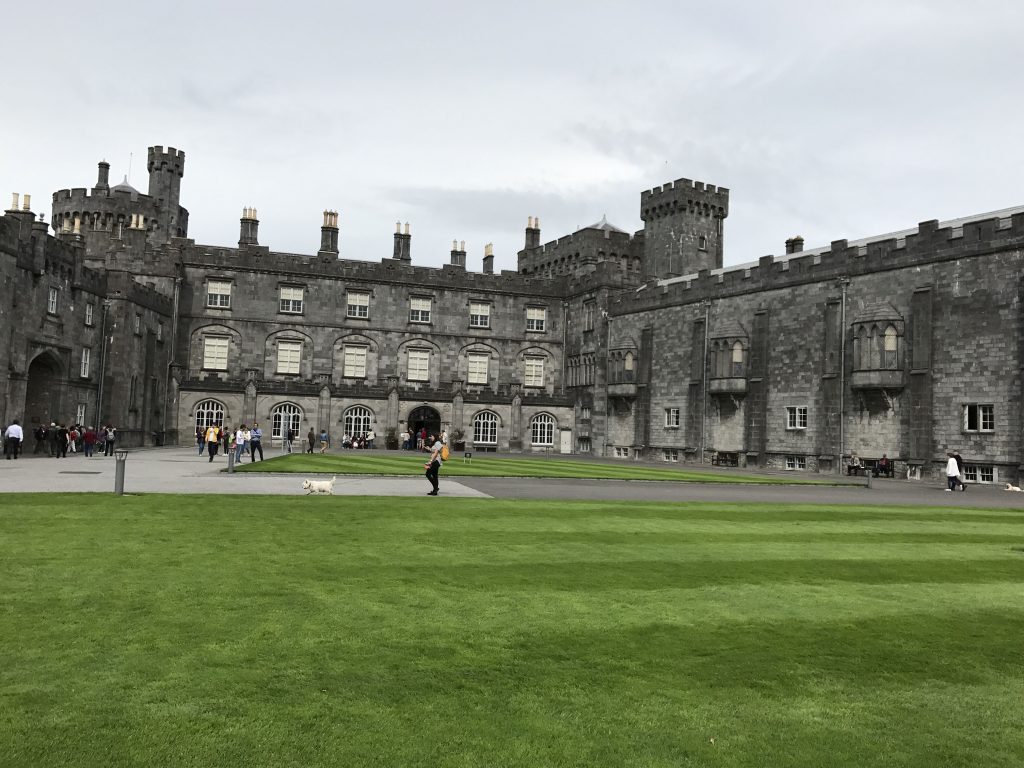
On the 25th, we left for Kilkenny, and as we drove south through the beautiful countryside we soon discovered that all highway intersections had roundabouts, so there were very few traffic lights. In Kilkenny, hurling is a very popular Irish sport and it is said Kilkenny babies are born with a hurling stick in their hand. We got off the bus at 10:20 and were on our own until 1:00. Some people took a small road train ride around town to see what was there and others took a different street than us and saw St. Mary’s Cathedral. Some toured the grand Kilkenny Castle built in 1195, which had most recently been owned by the Butler family for 300 years, then was transferred to the town in 1957 for £50.
We drove south to Waterford and toured the House of Waterford Crystal that began business in 1783. We went through the factory where they explained and showed us how it was made, as well as how they made one-of-a-kind items. We saw them blowing the glass, shaping, baking, grinding, marking and cutting it and it was fascinating. We were told about the final polishing phase and ended in a room with finished pieces, then to the showroom where beautiful pieces were for sale.
We walked down the street 2-3 blocks to our Tower Hotel Waterford, which was next to River Suir with docks and boats. This was where the Vikings had sailed in. After getting our rooms, a few of us toured the large round four story Reginald’s Tower across the street from the hotel. It had been rebuilt in stone with floors added in 1185. Between the hotel and the tower there was a statue of Thomas Francis Maegher, who is credited with being both an Irish and American hero. He led the “Fighting Irish” for the Union in our War Between the States and then was interim governor of Montana. He is also credited with developing Ireland’s orange, white and green flag and we saw the building where it first flew.

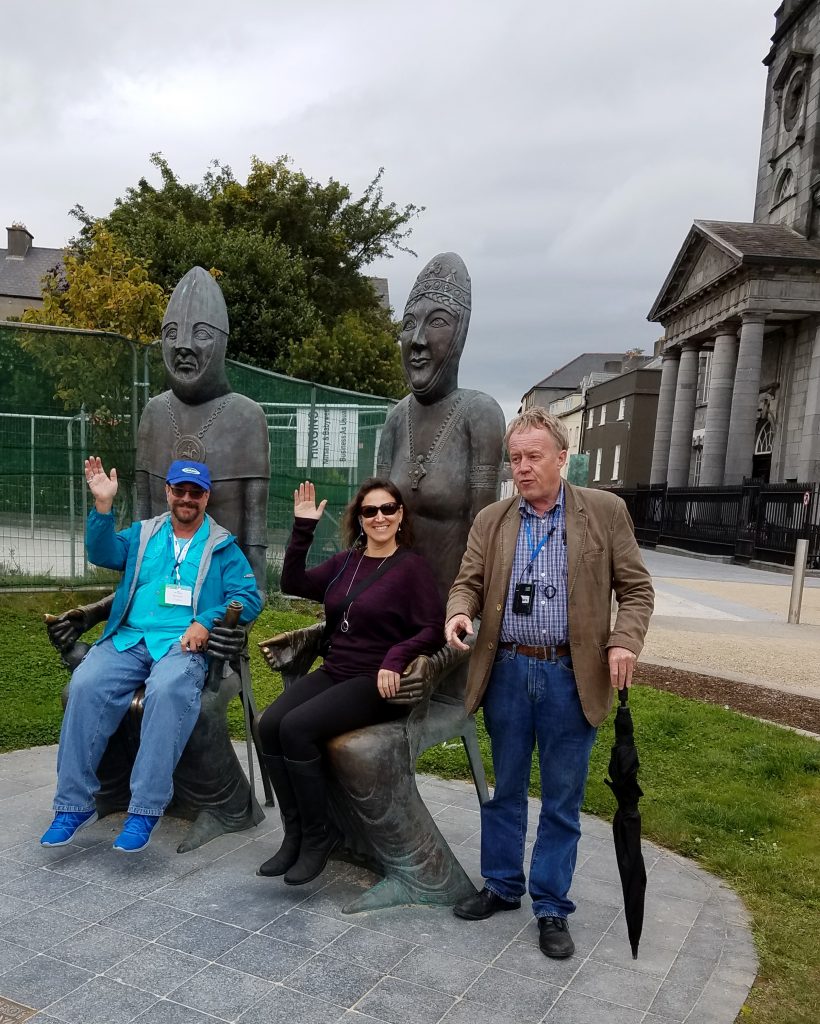
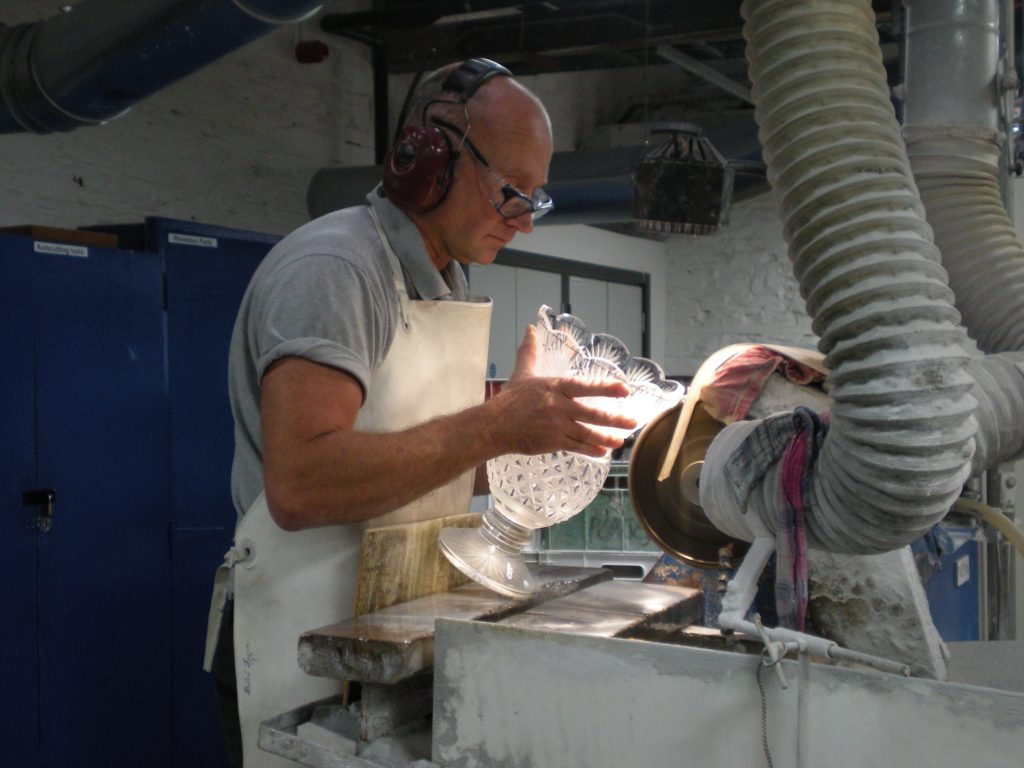
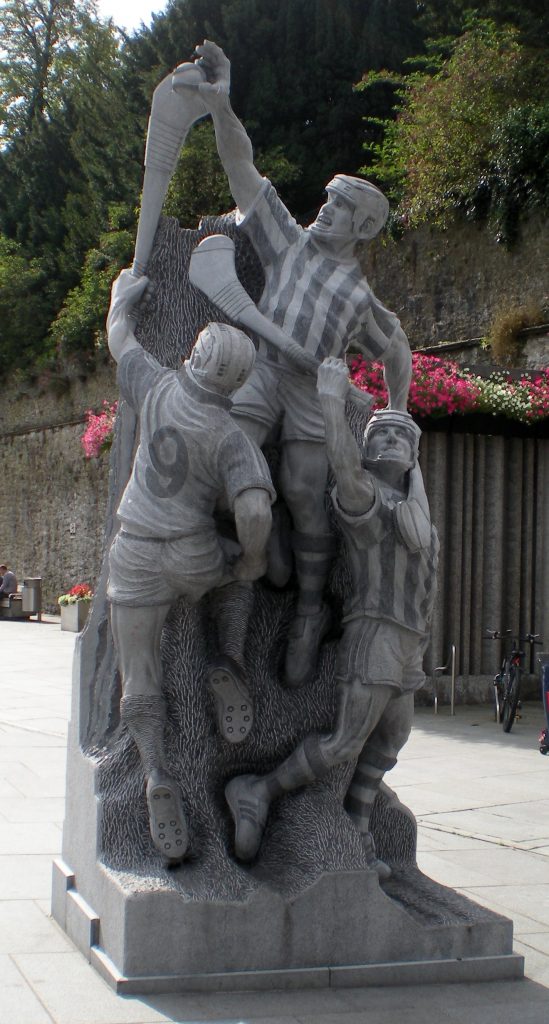
At 5:30 we left on a walking tour of Waterford with a local guide, Jack. We went by Reginald’s Tower with a Viking Longboat replica beside it, up the street to see ruins of Greyfriars French Church and a carved wooden face “King of the Vikings”. We went by Christ Church Cathedral (Protestant), rather plain with no stained glass windows because the builder, John Roberts, born in Waterford in 1714, did not like stained glass windows and he lived across from it. He also built the Holy Trinity Cathedral (Catholic). Beside the first Cathedral Jack conducted a fun role playing, where he was an old king who married a young woman, chosen from our group. She left him after a few years and married Diarmait Mac Murchada (anglicised Dermot MacMurrough), king of Leinster, also chosen from our group. Their daughter married Strongbow, both chosen from our group, and they ruled Leinster after that, sitting in throne like chairs in the plaza and waving. We continued our tour and walked into the large and beautiful Holy Trinity Cathedral where several Waterford crystal chandeliers hung. Down the block we ended the tour at the Clock Tower on the Quay and Jack pointed out the way straight down the street back to the hotel. Some of us took a different way back and walked by a band playing under a tent (which we could still hear from our hotel room later), then walked down an alley with houses and people putting out banners with the colors of the hurling team they were supporting as the national tournament was on September 3.
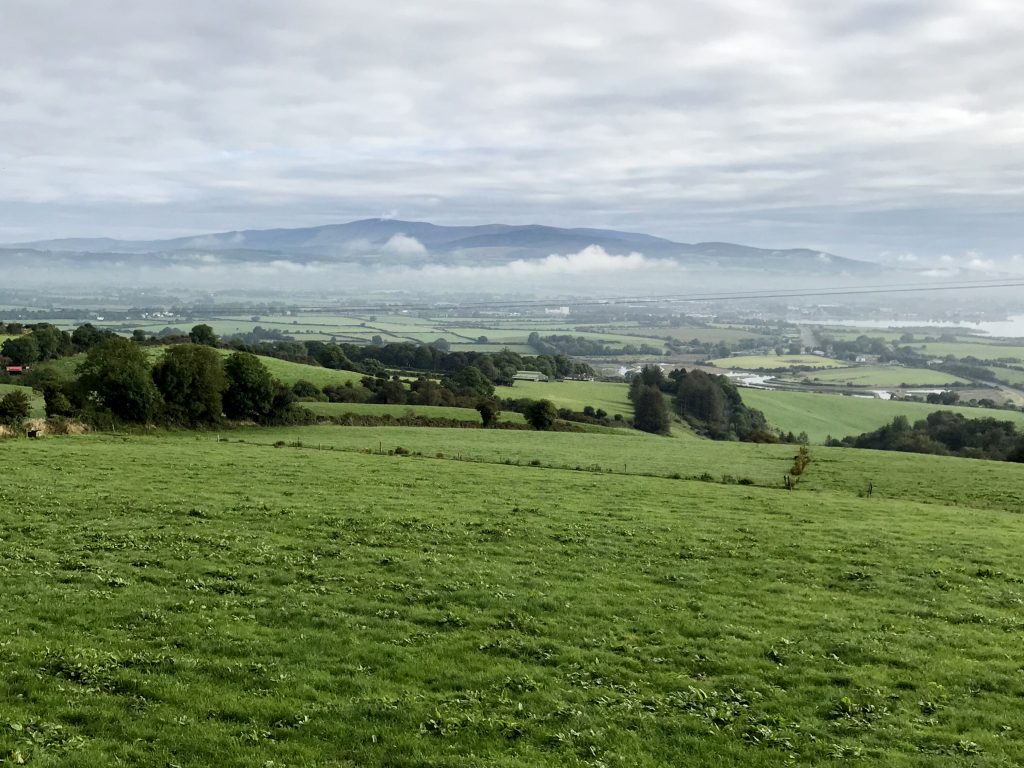
The morning of Aug 26 we stopped at the top of a hill overlooking the countryside and the Irish/Celtic Sea near Dungarven to take photos. We had good weather! There were green fields with hedgerows as fences around them. Hedgerows provide a place for wildlife to live under and they keep cattle in. On the south coast, we passed through the town of Youghal, pronounced like Y’all, in Co. Cork and was the first Irish town where Vikings lived, in the 11th century per Wikipedia. In the 16th century Queen Elizabeth I gave Youghal to Sir Walter Raleigh and he lived there for a time, with his house still there. In Killegh, west of Youghal, we saw an old church ruins and a building with a thatched roof beside it. Henry Ford, who was Irish, manufactured Model T’s and other Fords in Cork in the early 1900s to 1980s. Now the Ford plant is gone and no cars of any kind are manufactured in Ireland.
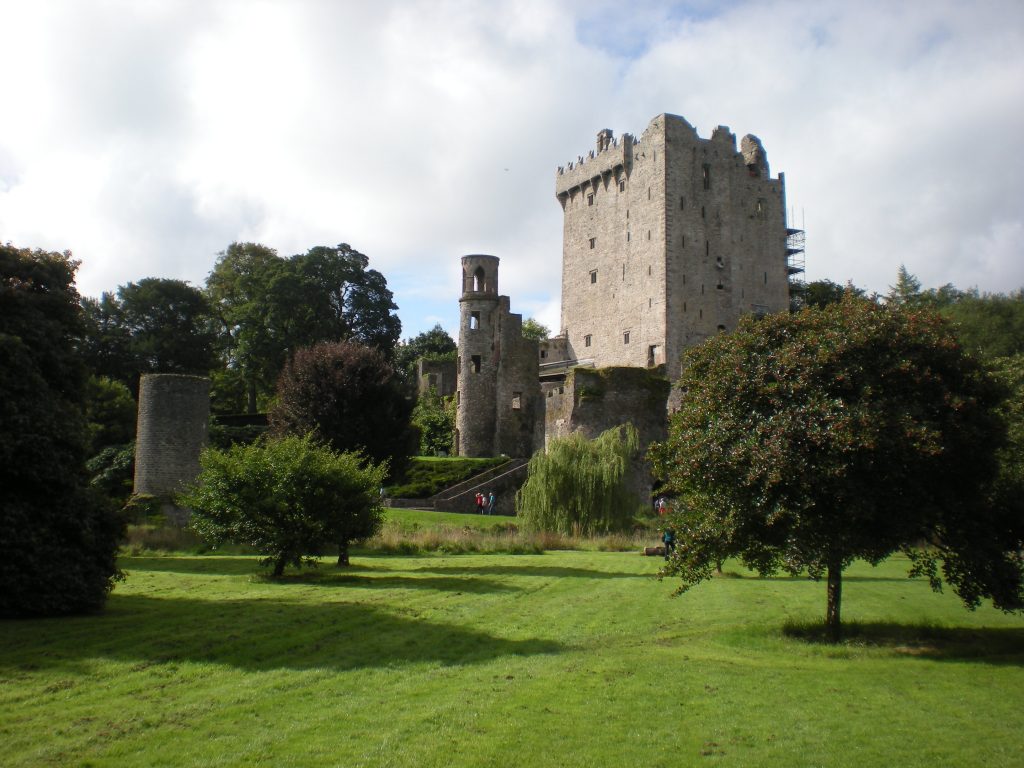
We arrived at Blarney and several of us climbed the spiral stairs to the top of Blarney Castle to kiss (or not) the Blarney Stone. All but one of the main castle floors are gone, but there was a diagram of what each floor would have been and we were able to go into what would have been some side bedrooms and the kitchen. We went up the spiral stairs in one corner of the castle and down spiral stairs on another corner of the castle, going into some areas where steps went off the main staircase on each floor and the dead end room appeared to be the privy with a slit in the floor and a grate over it now. There was a murder hole above the entry to the castle. If invaders were to get into the castle, hot oil, stones or arrows could be rained down through the murder hole onto the invaders as they entered.
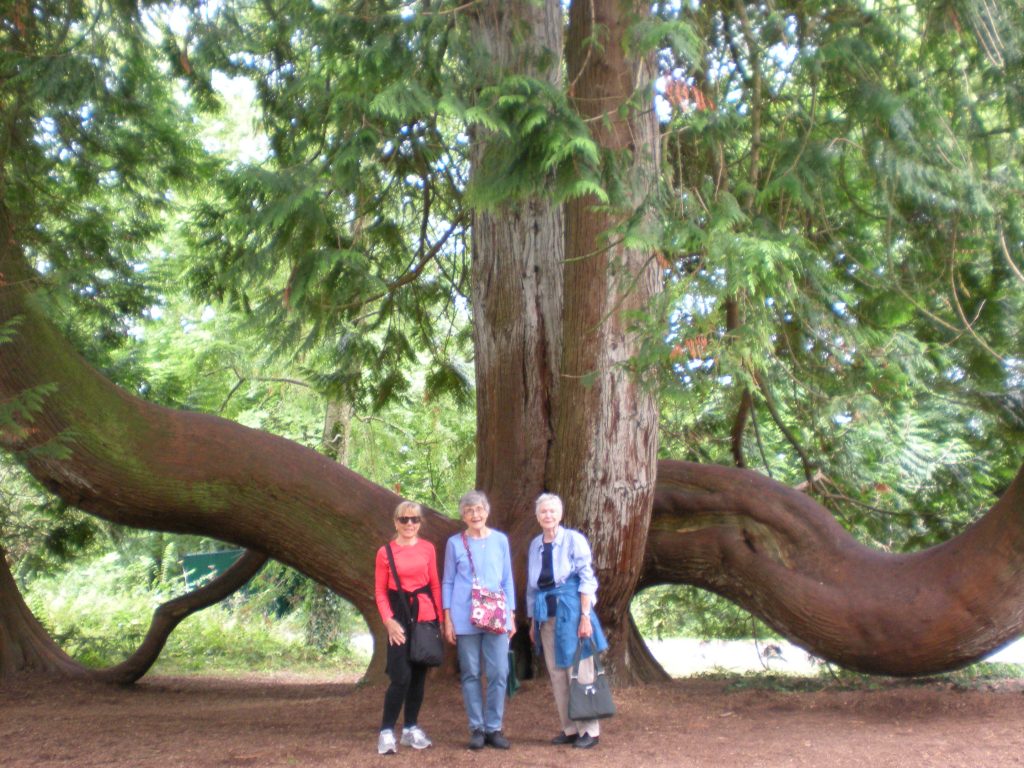
The grounds of Blarney Castle were beautiful and full of different areas to explore. There was a Poison Garden behind the castle that had all poisonous plants. We started to the Fern Garden & Waterfall when we saw a lovely huge and old Western Red Cedar tree and I got a picture of Suzanne Huff, Diane Martin and Anne Dibble in front of it. We continued on and found the 5’ tall and large Dicksonia Antartica ferns, the largest of their kind in Ireland, and a nice quiet waterfall about 12’ high. We walked around that and followed a trail back to the castle, passing a large icehouse which had recently been uncovered from the overgrowth. A little after that we came to Badger’s Cave, with a sign that said when Cromwell’s general, Lord Broghill, besieged the castle, the valuables, including a gold plate Broghill expected to claim, were gone, having been taken out through this cave. The passage to the castle has obviously been filled since that time. We went into the cave bent over and it opened up and went back several feet. A dug out room was off to the left and the main trail curled around to the right and ended.
Then we walked by the Watch Keepers or Lookout tower that I had been taking so many pictures of from above, probably restored in the 19th century and the spiral staircase within is no more. The base showed it had earlier been part of a curtain wall around the castle. On the grounds were also the Blarney House, a stable yard and so many different kinds of trees and flowers.
We saw plants that are like giant rhubarb called Gunnera Manicata growing by a creek, along with other bog plants, then walked by many flowers, butterflies and “The Three Wise Men”- three Yew trees that are 500-600 years old. As we went down the walk to leave, there were two rows of trees that had knitted designs all around the trunks, just like the ones that were in Austin by the Blanton Museum of Art a few years ago.
On the bus ride, John explained about their health care, then explained there are two types of the Celtic language. The Q type of Celtic language is used in Ireland and Scotland and a P type of Celtic language is used in Cornwall, Wales and Brittany in France. They are not the same and the Qs and Ps have a hard time understanding each other. We drove through Macroom, where William Penn Sr. (our PA Wm Penn’s father) owned land that had been granted him by Queen Elizabeth I. William Penn Jr (our PA Penn) was given land next to Macroom by King Charles II to pay a debt.
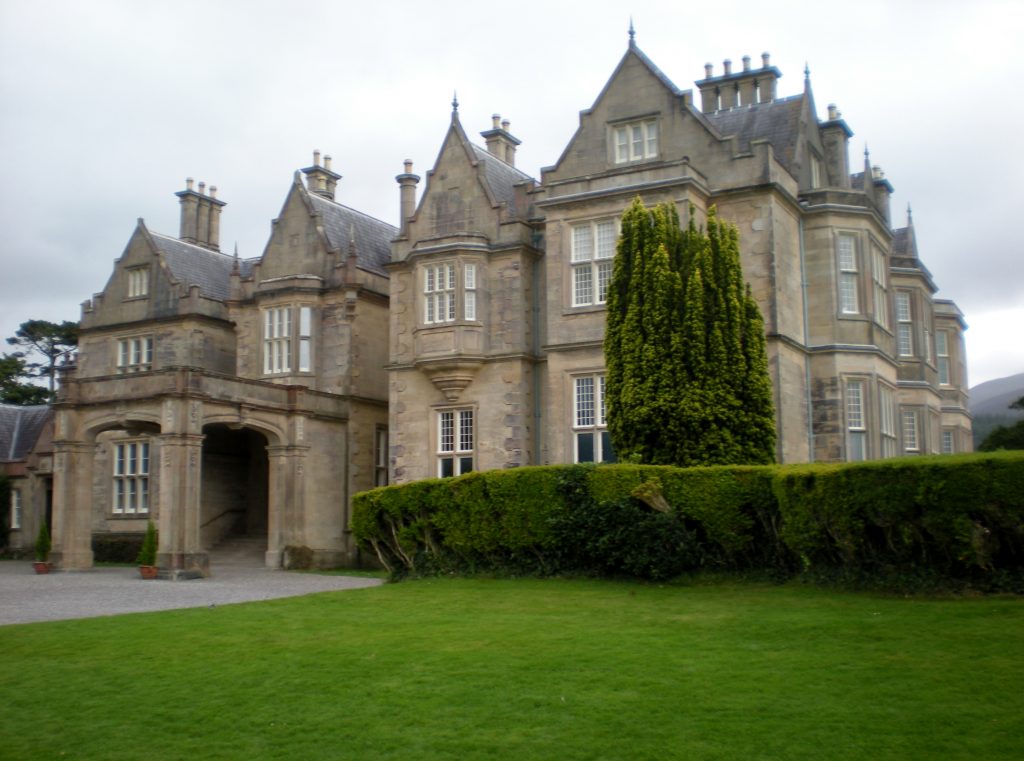
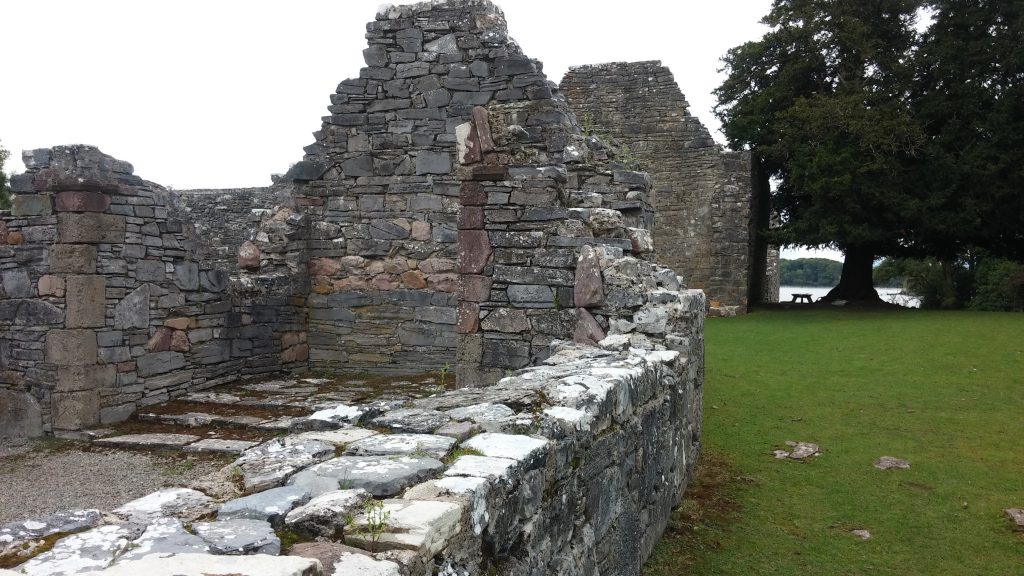
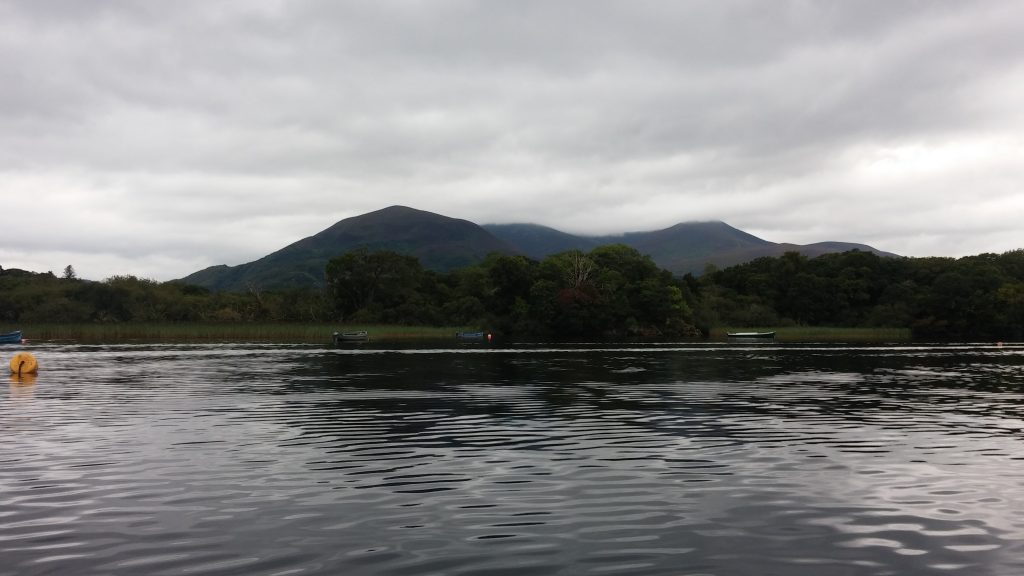
We arrived at Ross Island for a boat ride on the Killarney Lakes where most of us were dropped off by Ross Castle and we walked to the docks beside it. The bus left with the others who had chosen to tour the Muckross House. We boarded a few 12 passenger motor boats and glided past beautiful scenery in the black water of Lough (Lake) Leane of the Lower Killarney Lakes. The water is black because of the tannin in the peat bog below staining the water. We approached Innisfallen Island that had the ruins of the ancient Innisfallen Monastery and debarked. We were able to explore at our leisure and found there were many deer there as there were no natural predators on the island. The ruins were quite interesting to look at up close and there were two very large trees with winding and intertwining roots and rocks at the base. We went back the way we came to Ross Island and picked up those at the Muckross House. The 65 room Victorian Muckross House mansion was built from 1839-1843 on an 11,000 acre estate within the Killarney National Park. Several of the rooms were toured as well as the basement which was the kitchen and 32 bells were seen for the servants. It made one feel as if they had toured Downton Abbey. It was close to three lakes and the grounds were well manicured and lovely.

We drove to Killarney and saw the Jaunting Cars, which are horse drawn open air ‘cabs’ with two rows of seating going front to back, driven by Jarveys. We checked into the Killarney Towers Hotel, our nicest one so far. We all met at 6 and walked three blocks in some drizzle to the restaurant for dinner. Afterwards, some of us attended a free Irish and African music show at a church across the street from our hotel. It was hard staying awake after such a full day.
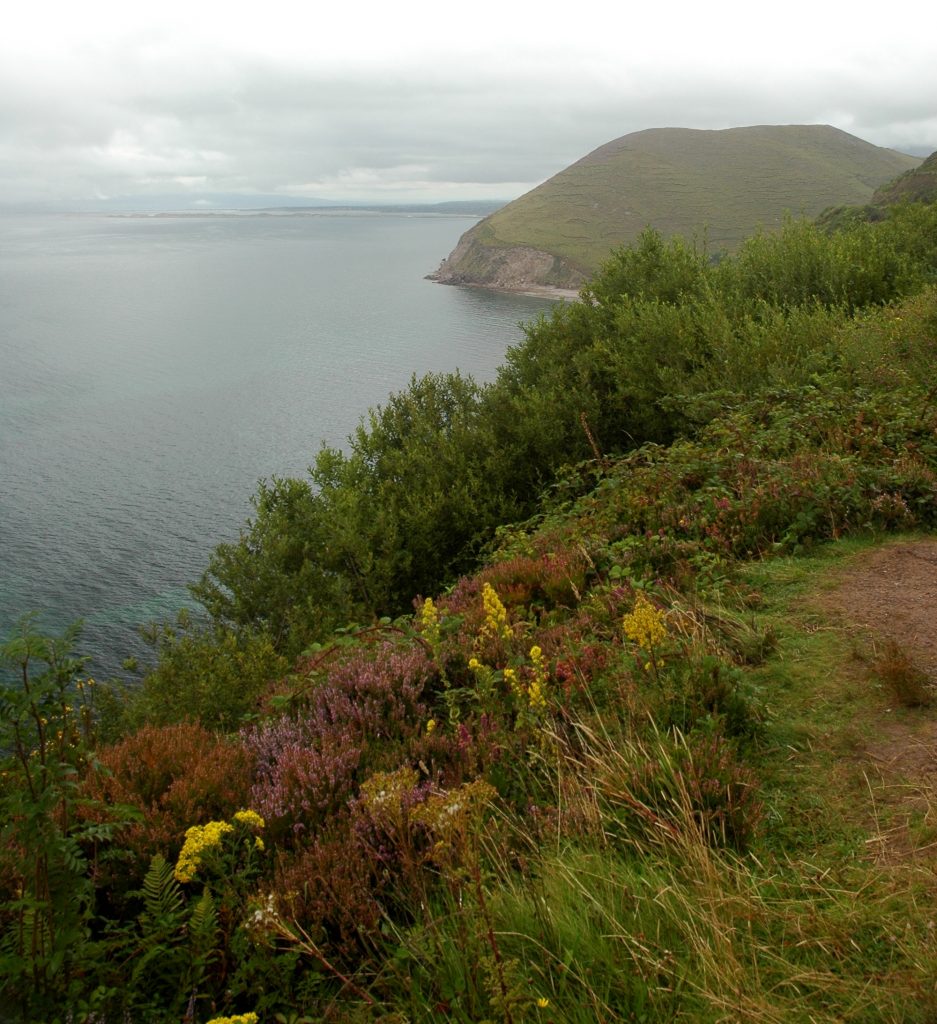
The next morning we started the Ring of Kerry tour which goes around the Iveragh Peninsula in Co. Kerry on the west side of Ireland. We started at the northeast end and stopped at Moriarity’s, a local artisan crafts shop with many woolen scarves, hats, sweaters, coats and throw blankets, and other souvenir type things. Our group picture was taken in the parking lot afterwards.
After a short time, we drove very slowly by about seven Ogham (pronounced om with a long o) stones in a group, which were upright marker type stones that would have had a chieftains name at the bottom and were used to put in the ground to mark land boundaries, and sometimes the stones also marked graves or burial sites. Ogham was the first form of Irish writing that dates back to the 3rd century AD.
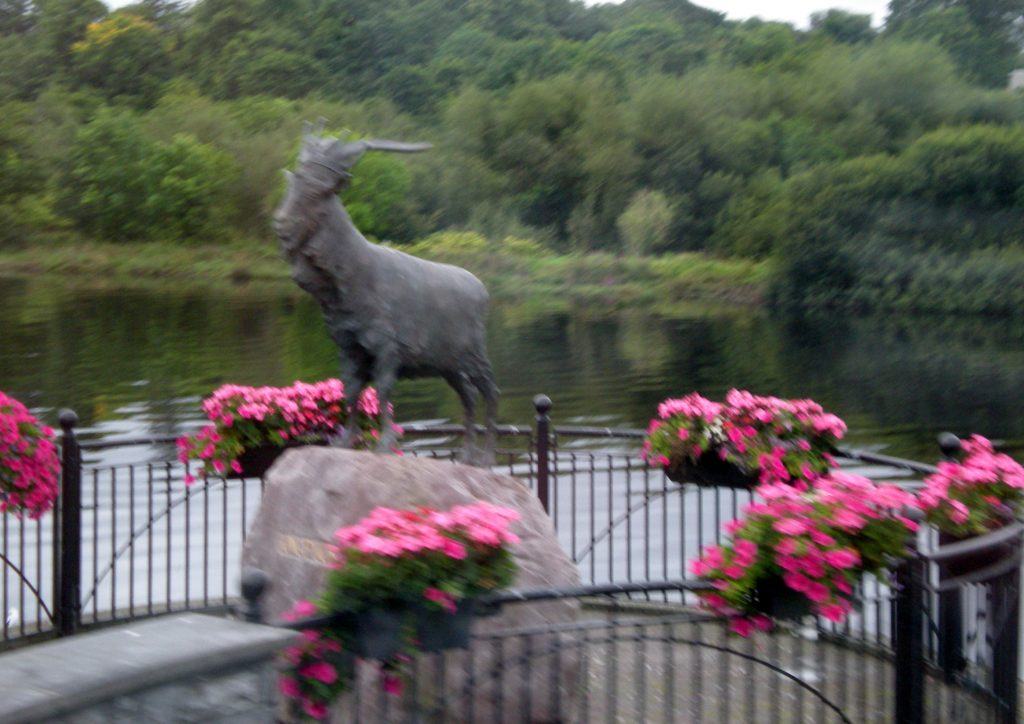
We drove through the town of Killorglin where they have a Puck Fair every year. Puck is the Irish name for goat and there is a Puck King (real goat). Goats are a sign of fertility and they also alerted the villagers to the coming of Cromwell, so to honor the goats they have three days of drinking, dancing and carousing during the fair and pubs are open around the clock. We passed a statue of a Puck King, a goat with a crown on its head.
The towns in Ireland have a friendly competition called Tidy Town and a winner is chosen at the beginning of September. All the towns clean up and have flowers planted (we saw MANY flowers). The winner gets bragging rights and it benefits everyone due to the cleanup and beautification. We were lucky to be there when we were.
We stopped along the side of the road where there were two people selling things. One was a man weaving large grass of some kind into an Irish design and next to him he had a donkey with baskets on its sides and a dog sitting on top of the donkey. The view of the countryside was wonderful and we took many pictures.
We stopped in Waterville on the tip of the peninsula on the Atlantic Ocean for a break. There was a statue of Charlie Chaplin, who with his family loved the hospitality of Waterville and the Butler Arms Hotel. They stayed there for part of every year from the 1950s until 1970, when the Troubles began. His children still visit and there is a Chaplin Festival held each year.
John told us about many actors from Ireland and films that had been done there. He pronounced film as filem and we got a chuckle from that. It must have been the Irish way of saying the word.
We stopped at a high point at Scarriff Inn for lunch, which advertised it had the “Best View”. There was a heavy mist and fog, obliterating any view over the railings, which would have been the land and sea below. John said it was foggier than he had ever seen it there. When we left, Tom, our driver, had a precarious drive in the foggy mist, hugging the mountain in the left lane on a narrow road and we were all glad he had driven it before. When we got to a lower elevation, the weather was much clearer.
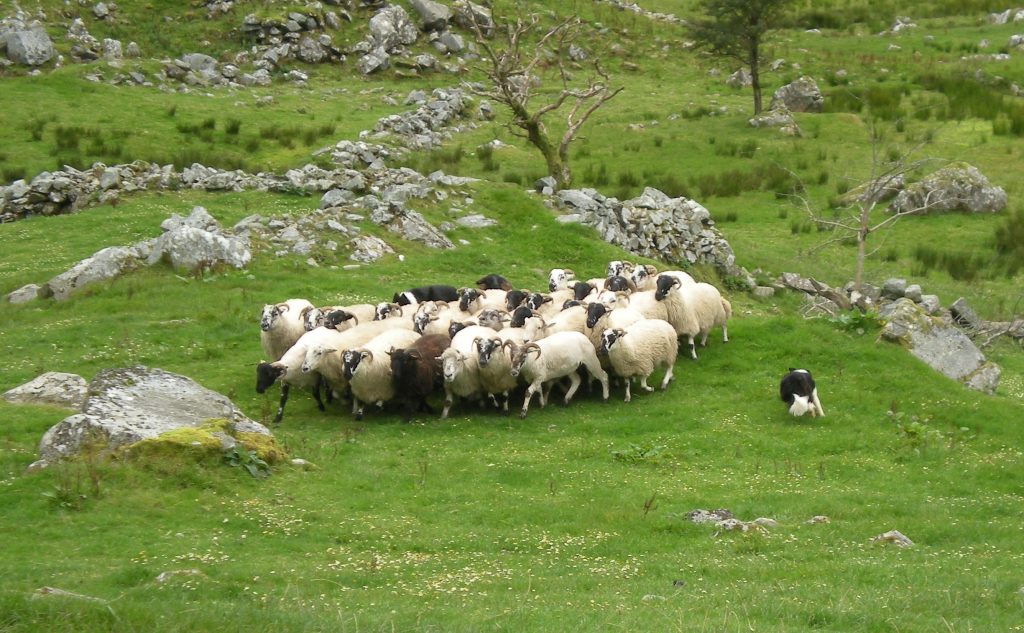
We arrived in good weather at the Kissane Sheep Farm, a working farm owned by the same family for 200 years. The 5th generation sheep herder, John, and his 8 year old son Sean, demonstrated herding the sheep using two of their three border collies. John used German word commands for left, right and possibly something else. He also said “straight on” in English and had at least two different whistles which meant to move up or drop back. He would say a dog’s name and then give the commands and that dog would do just as he said, running around the sheep on the craggy hillside, guiding them to the pen where Sean was waiting with the gate open. The sheep tended to gather around John and he led them into the fenced area, then he had the dog run them back down the hill. John explained the sheep see a dog as a wolf, a natural enemy, and that is why they run from them. They had hundreds of sheep in the hills around there, so having the dogs saves many hours of time gathering them. It was quite fascinating. We went into a building, through the gift shop into an area where a professional sheep shearer expertly demonstrated his craft on one of the sheep, using long hand shears first around the head, neck and foreleg, then electric shears. When he was done, he gave it some medicine with a tube down it’s throat, gave it an innoculation in its neck and then used an iron with a K dipped in red paint to brand it on its front flank and used a paint brush dipped in red paint to put a red patch on the top back of the sheep. This indicates whose sheep it is and that it had its medicine and shot. He also held up the large piece of sheep wool he had just shorn and it went into a large bin with other wool. Another person explained the different uses for lanolin from the wool and passed around three jars of different lanolin we could sample, ending with us going into the gift shop to purchase items. Because of Britain leaving the EU, the sheep farmers cannot get anything for the wool they used to sell to them, so they are now dependent on tourists and probably the sale of lamb for meat.
After dinner that evening, John arranged for those who wanted to go to a professional touring Gaelic Roots show, whose last performance was nearby that night. We paid for our tickets there and enjoyed an evening of music and Riverdance style step dancing by three women and a man. A group of three Irish sisters sang beautifully in English and Irish/Celtic. One man played a solo on the bodhran drum and he made it sing with several different sounds depending on where he held it with his flat hand and where he beat the stick. Another man did a solo, sitting on a wooden box and beat the front of it with his hands like a drum. There were also regular drums, a harp, saxophone, guitar, keyboard and violin used. It was a fantastic show and an unexpected treat.
Nearly all the signs in the Republic of Ireland are with the Irish or Gaelic on top, then English under and it is interesting to see how it translates. The grade school children in Ireland learn the Gaelic language, but don’t use it so much in secondary grades. Northern Ireland is part of the UK and you don’t see the Irish language on their signs.
Aug 28 we loaded our bags onto the bus, then walked one block to the Jaunting Cars where the Jarveys were waiting for us. Each seated 8 plus the Jarvey and we went down the street into an entrance of Killarney National Park, where we went by an old gate house with a very pretty thatched roof and is now a tea house. We went along a narrow road that was for foot traffic and the carts, between the green grass and trees, along a stream and fields with black Kerry cows, and then by the Killarney Lower Lakes, where we could see Ross Castle in the distance. The cars were pulled by horses that are a cross between a Clydesdale and Irish draft horse, but much smaller than a Clydesdale.
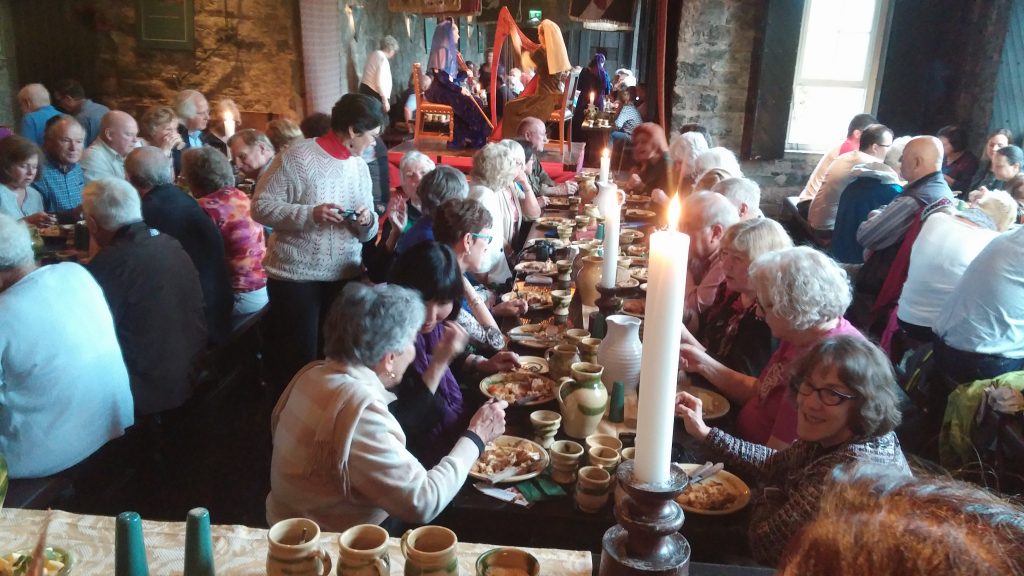
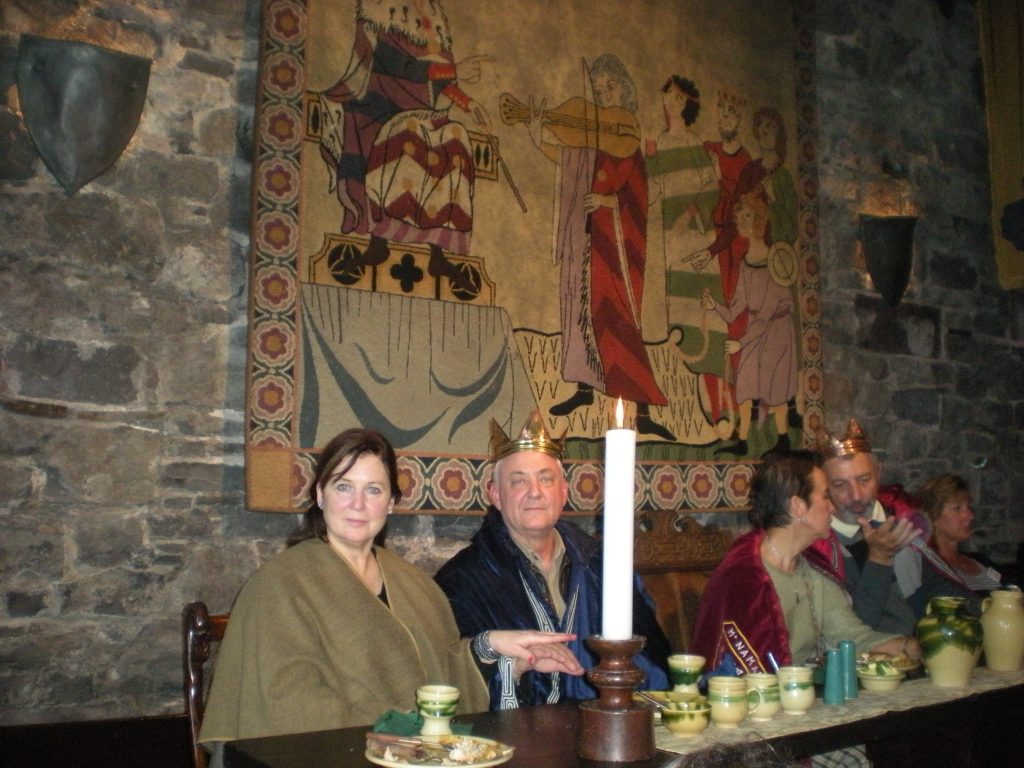
As the bus drove along the coast, we saw several wind turbines on the landscape producing energy. They are along the coast points as they have the ocean winds to keep them running. Our bus took a ferry across the Shannon Estuary and after a while we got to the Cliffs of Moher, but it was so misty and foggy, we could not see them. At one point, the mist partially moved out and the lower part of the cliffs were partially visible for only a few minutes before the mist settled in again. We drove to our next hotel, The Old Ground (Ye Olde Grounde) in Ennis. It was an old manor house and the outside was covered in colorful ivy, with the inside very nice and elegent. That evening most of us had chosen the optional tour of a medieval dinner at the 14th century Knappogue Castle. There were three groups there and a king and queen of each group had been chosen by the tour manager prior to dinner, unbeknownst to them. Norm and Carmen Arn were ours. There was traditional medieval entertainment and the food was delicious. Interestingly, the castle in disrepair was inherited by an Irish woman who lived in Texas! She was an interior architect and helped design and directed building the inside to turn it into a usable castle again, then gave it back to the Irish people.
In the morning we traveled to Galway and were free to walk around for a couple hours. We saw a banner across the street that said “Best of Luck to the Galway Hurlers”, as everyone was looking forward to the upcoming national tournament (Galway beat Cork to win). We also saw a girl step dancing in a street intersection with a hat out for tips.
We left Galway and John pointed out trees on the field borders and sometimes in the field as hawthorn trees they call haws and also whitethorn. The Irish call these fairy trees and believe if they are cut down you will have many years of bad luck, so they don’t. Even when one was in the way of putting in a new road, no one would cut it down, so they spent 100,000 Euros to reroute the road.
There are lots of ruins in Ireland, 14th century buildings, castles with only walls standing, and church ruins with graveyards around them. Stone buildings with corrugated metal roofs used to be thatched roofs.
Peggy Mueller is very knowledgeable about flowers, plants and trees and she wanted to see gorse while we were there. I believe this was the day her wish came true when John pointed out the yellow flowers while we were on the bus.
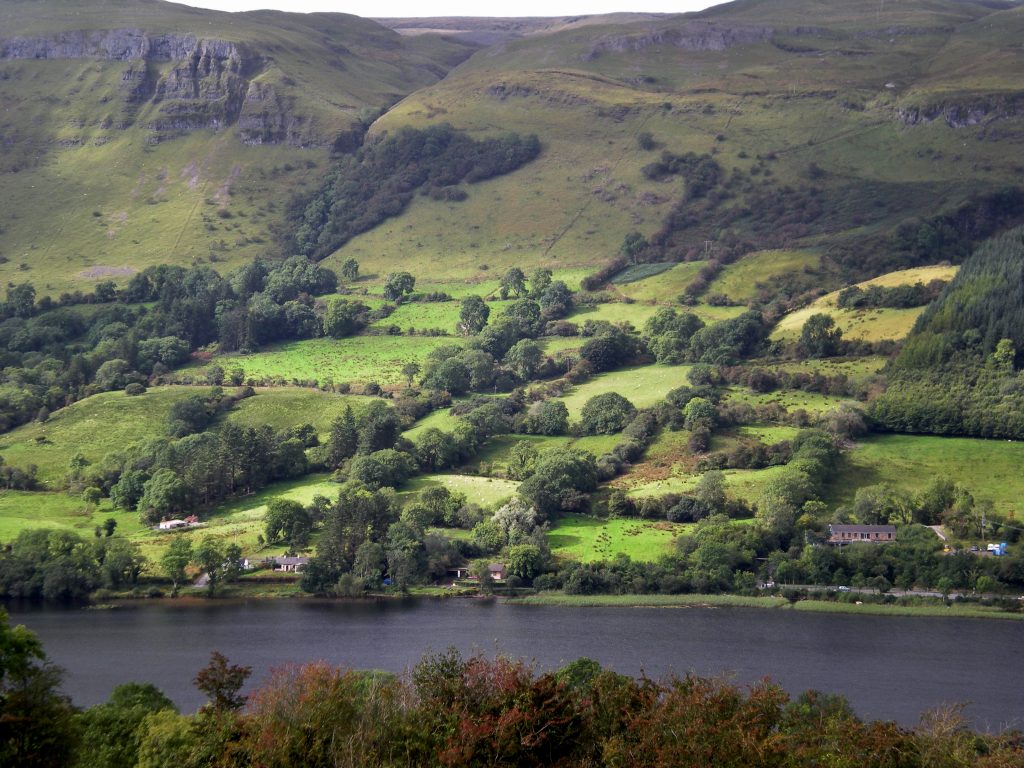
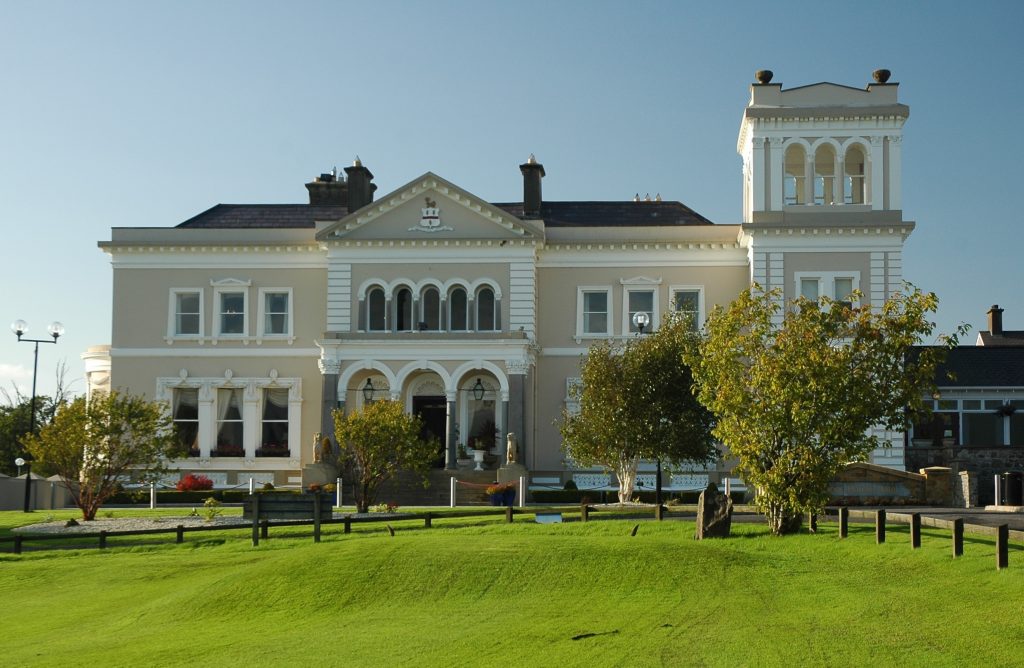
After we drove through Sligo, we saw large hills/mountains with beautiful rock and green fields at the base and a waterfall. We stopped for a photo op there and it was magnificent. We crossed the Northern Ireland border into Co. Fermanagh and went to Enniskillen to the beautiful Manor House Country Hotel, where we stayed one night. It was a most beautiful and elegant hotel, with Lake Erne beside it and a golf course. It had been a manor house until 1957. Our room even had a TV at the end of the bathtub!
The next morning we drove past purple heather growing on peat bogs and we saw some trenches where peat had been cut out of the bog for the farmer to sell at market. Peat goes down 20-30 feet in the ground, made of decaying plants and trees over thousands of years. Each layer often has things preserved in it to tell a story of a time long past. It is used for fires to warm homes, but burns quickly and not real hot, so is good for cooking over. People used to store their butter in the cold bogs and butter is still found in them. Most farms are about 100 acres owned by families for generations. The younger generation now is going to college to learn how to farm better and they love the land. The farms in Co. Donegal are not tillable ground because it is bog, so they raise sheep.
We arrived in Ardara and stopped at Triona – the Donegal Tweed Visitor Center, store and Weaver’s Cottage. Mrs. Mulhern welcomed us and showed us how the woolen cloth is made, still on an old loom. Her husband, a master weaver demonstrated how it was done, using pedals to change the color of thread going in when the shuttle ran the yarn through and with one hand he pulled down on a rope to one side, then the other side moving the shuttle.
We headed to Donegal Town by the ocean and had about 1.5 hours to get lunch and walk around. Some people had fish n’chips there and I found it humorous that the restaurant toilet door windows were etched with “Buoys” and “Gulls”.
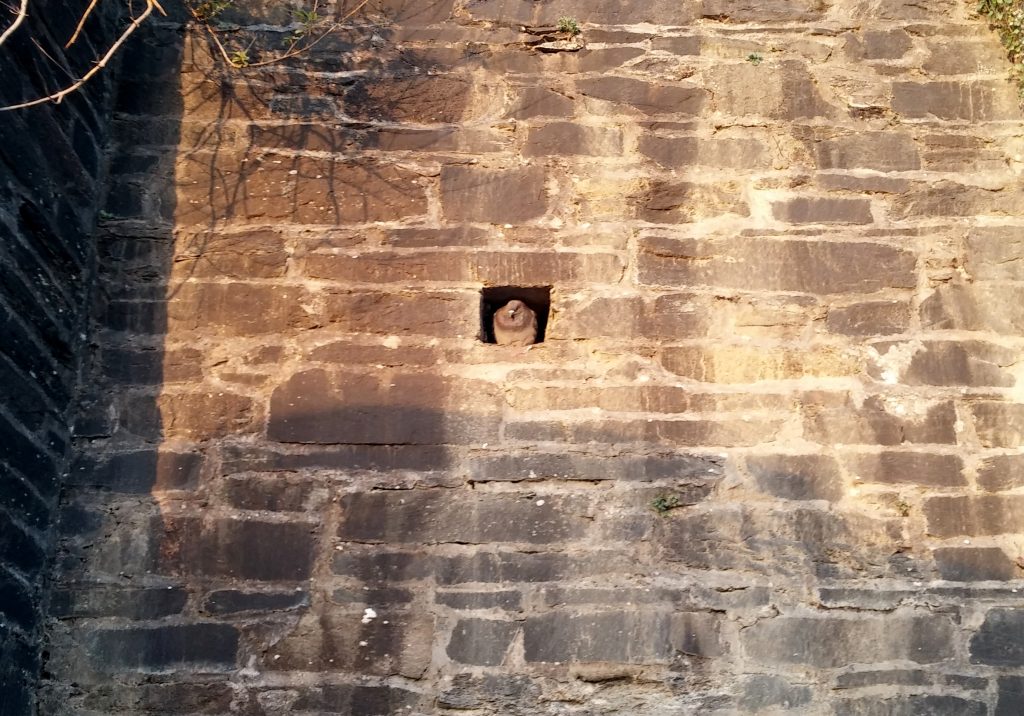
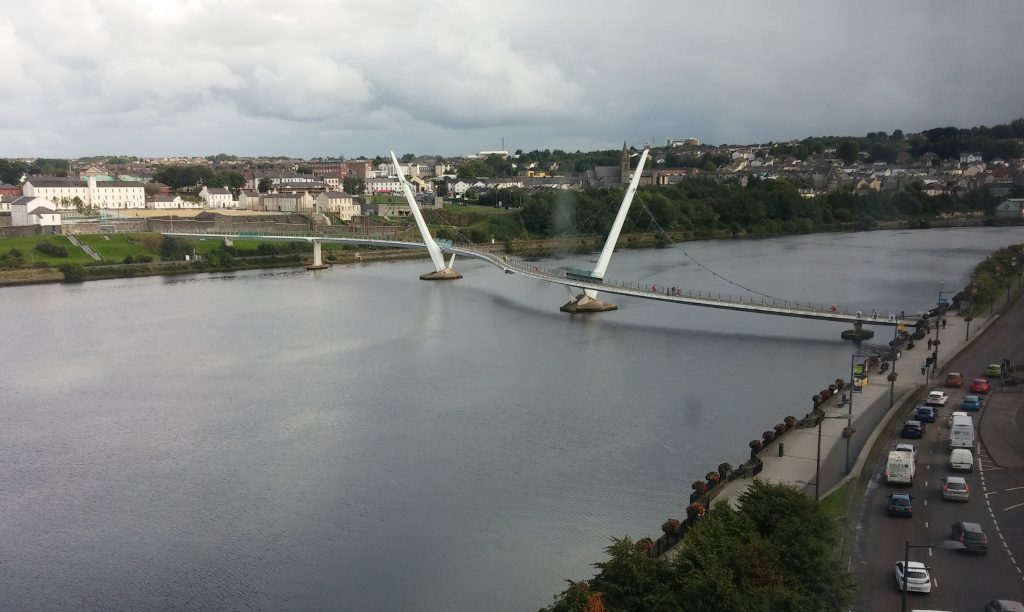
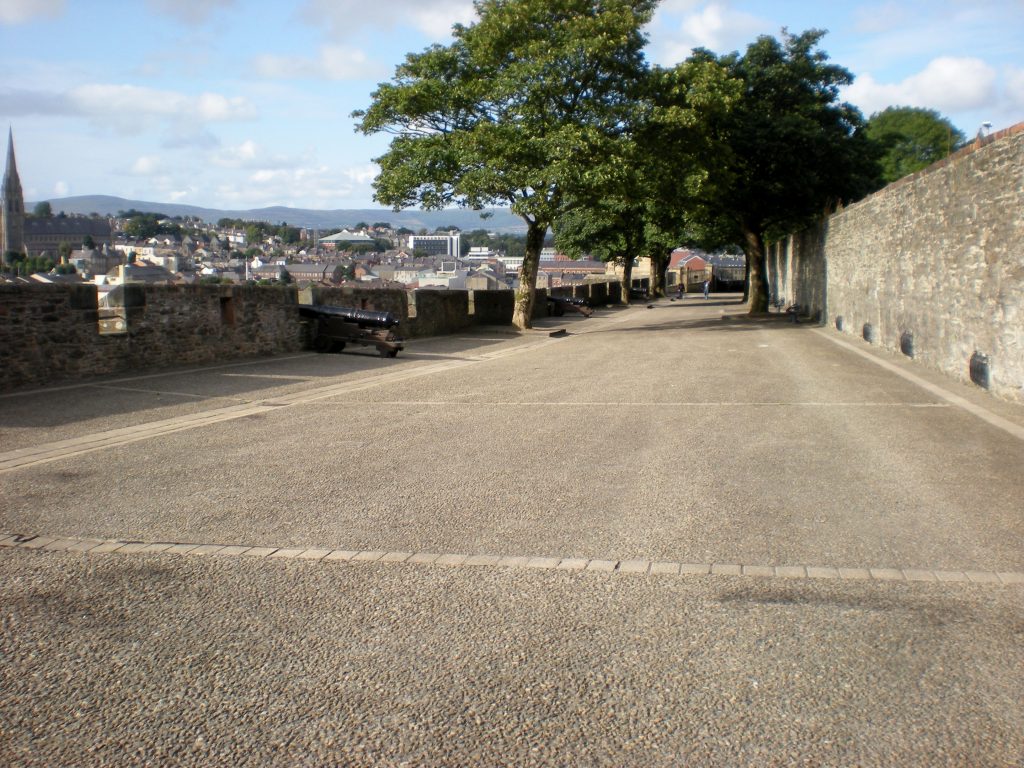
We arrived in Derry, in Northern Ireland, crossed the River Foyle over Foyle Bridge, then saw the bicycle and pedestrian Peace Bridge, known for two people of different fighting factions meeting in the middle, shaking hands, and helping start peace between the historically divided east and west banks. We had a late afternoon walking tour of Derry with a local guide, Ryan. The Republic of Ireland supporters call the city Derry. The British supporters call the city Londonderry, and it is also called the Walled City because it has a wall built between 1613-1618, with gates, around what had been the city at that time and was a defense against England and Scotland. The wall had cannons pointing out, situated every 20 feet or so. In 1642 even the Fishmongers (people who caught and sold fish) gathered their money and donated a cannon for the wall. Ryan told us about “The Troubles”, the IRA and the British. We walked by St. Augustine’s Church with old grave stones and a three colored hydrangea bush, and the Guild building with beautiful windows that was across a plaza from the big stone city wall.

The next morning we traveled west into Co. Donegal (Republic of Ireland) and went by a larger than normal farm that grew barley (for Guinness no doubt), grass for silage and raised cattle and sheep. We saw Ballyliffen golf course that was right along the coastline, and later huge sand dunes that were held together by Marram grass, giving it a striated appearance.
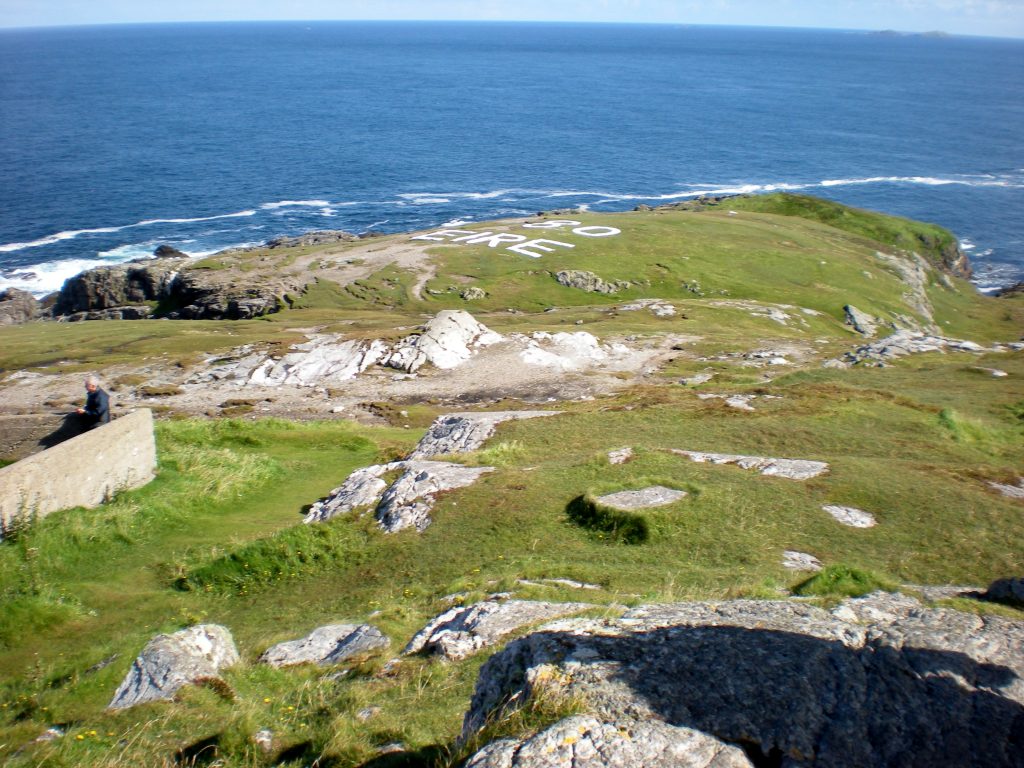
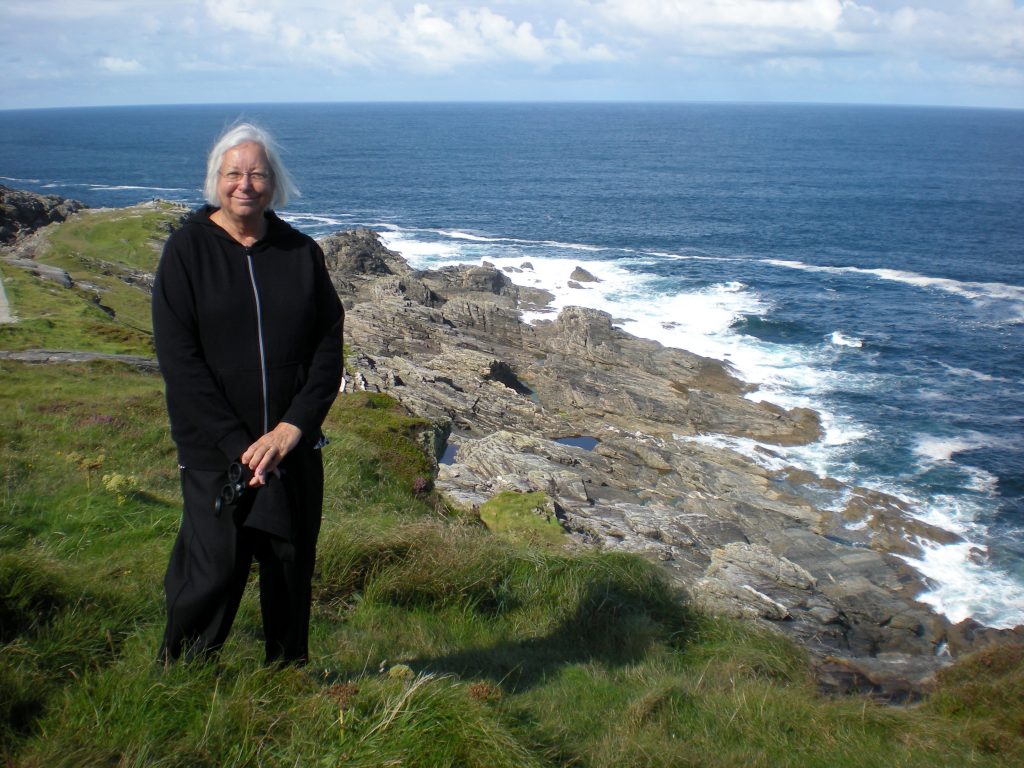
We arrived at Malin Head, the northern most point of Ireland and on the Atlantic Ocean. There was a watch tower there built in the late 1700s to look out for British. John said it was the best weather he had ever seen there, that the wind was usually so strong you could not stand out on the rocks like we were doing. Near the shore there were large white rocks that said the number 80 with EIRE under it. Eire = (Republic of) Ireland. John didn’t know what the 80 symbolized, but since it was close to Northern Ireland, EIRE was put there so the WWII planes would know it was not Northern Ireland and not to bomb it. It was picture perfect weather and some of us went down a steep trail on the other side of the point for that view too. From there we drove to Fallen’s Bar on Malin Head where several got Irish coffee – which has whiskey in it. The 8th installment of Star Wars had been filmed there and the outside of the building had a painted bust picture of Yoda and inside had a signed photo of a couple people from the film on the wall.
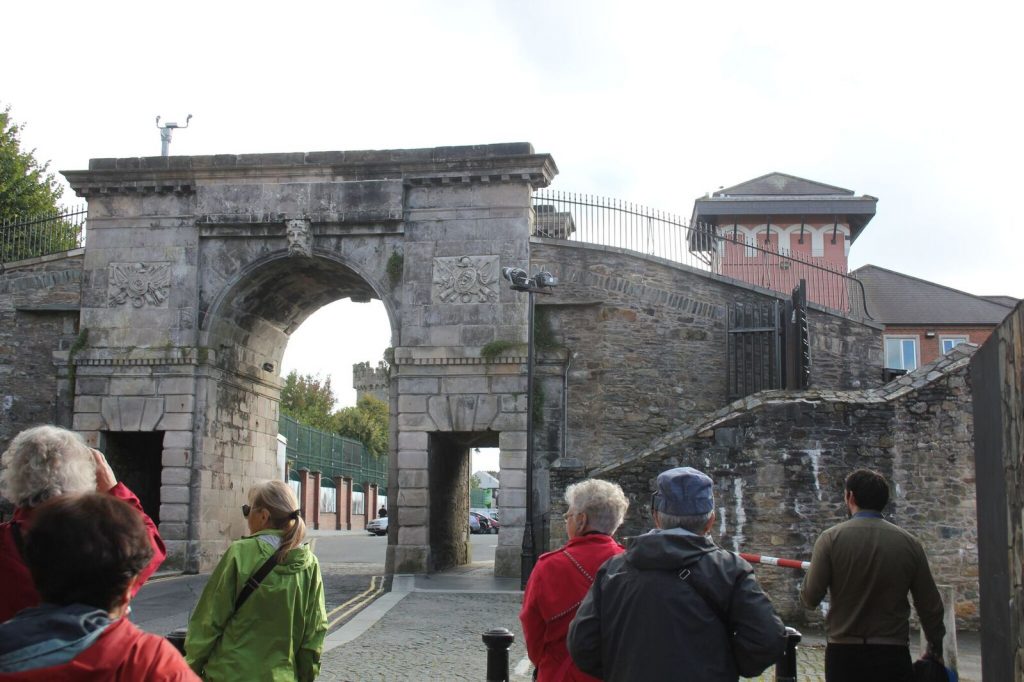
We went back to Northern Ireland to the centrally located Derry hotel at 2:30 and the rest of the day was free. Our small group walked to The Guild building and walked around the first floor that was free – gorgeous windows. Then we walked uphill on a steep street and went into Craft Alley to purchase a gift. Mike noticed the water piping was on the outside of the buildings and thought that was smart. We stopped in the “oldest sited bar” to see the menu and saw a Coors Beer coaster on a table, but the smell was not pleasant and we left. We walked under the Ferryquay gate of the wall, up a ways and back through, then went back to the hotel, looking at menus on outside restaurant walls along the way, deciding where we would eat, then after dinner used the hot tub and sauna.
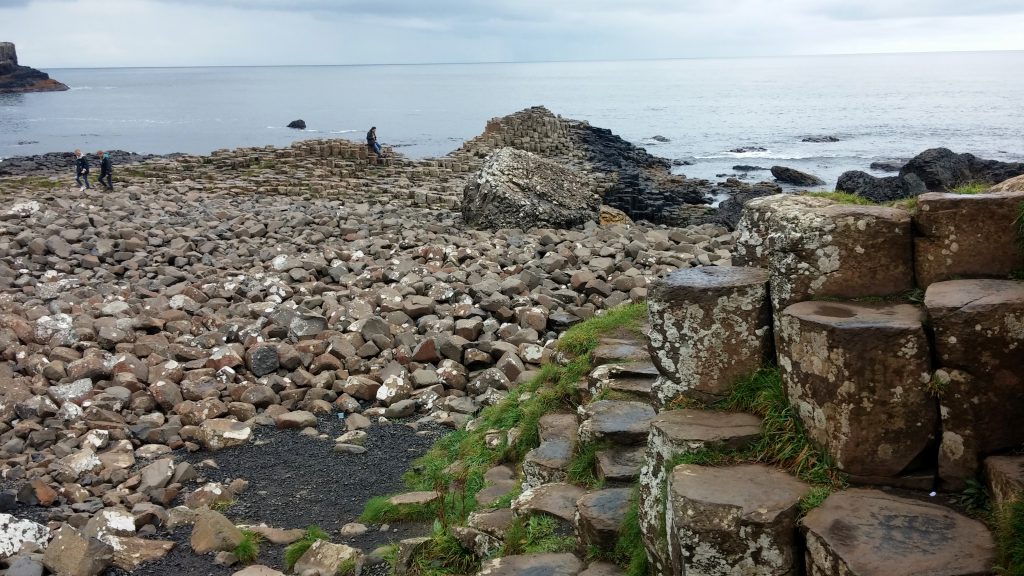

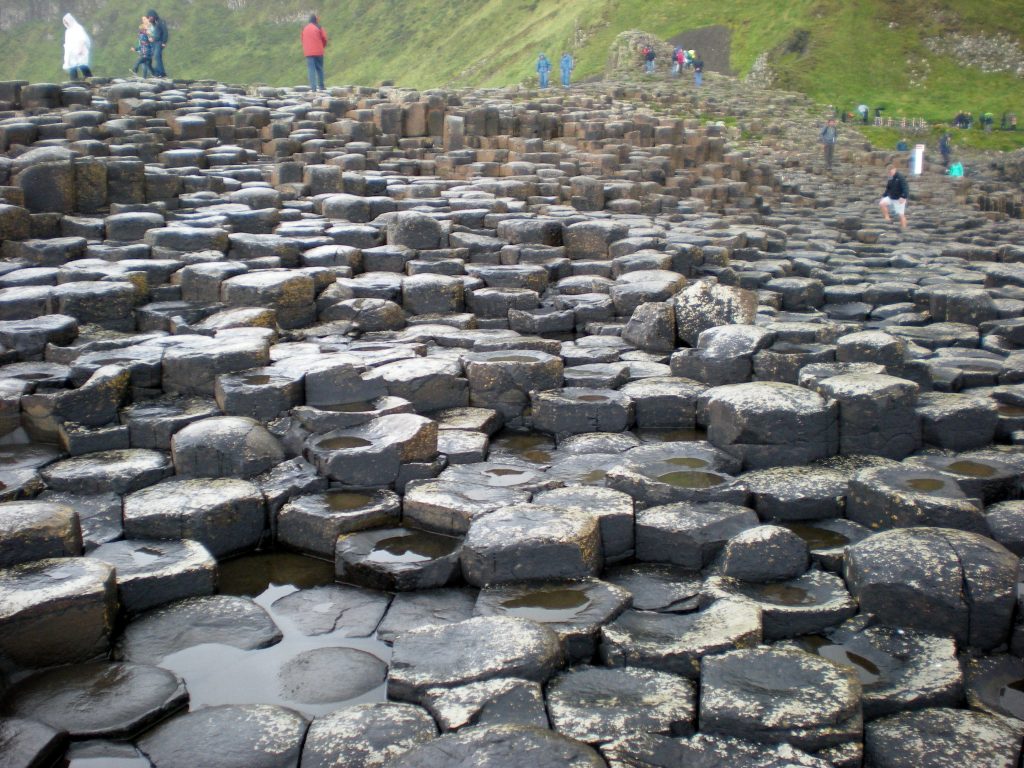
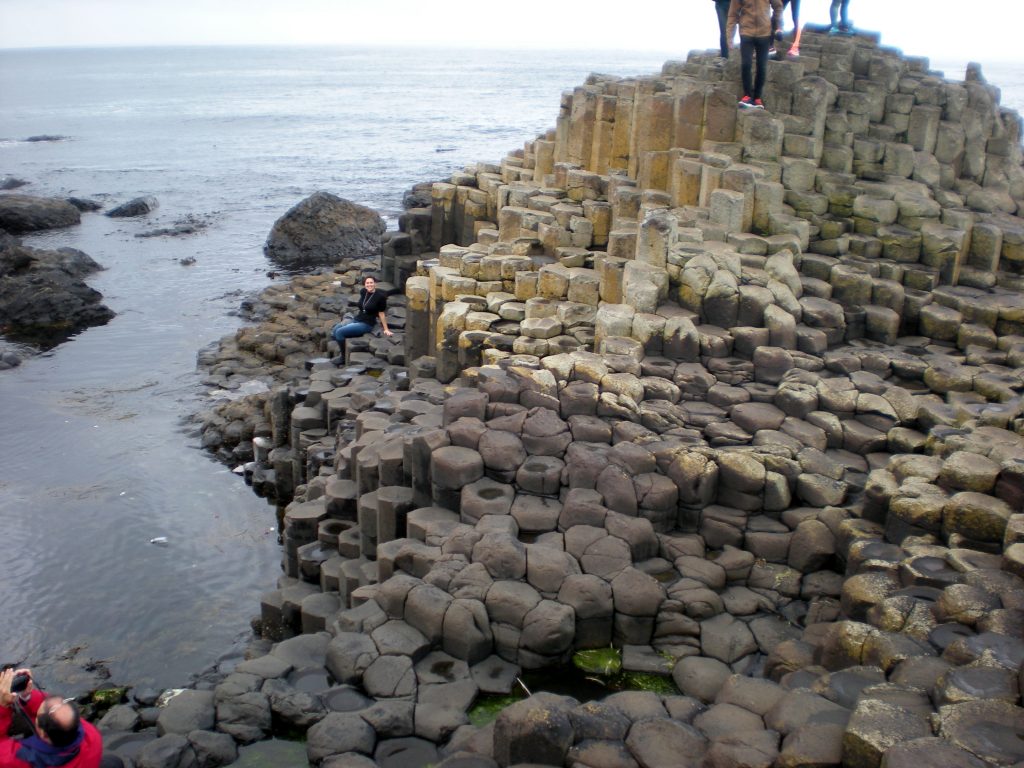
The next morning we left Derry and traveled east along the coast and saw more twirling wind turbines. It was a rather wet and dreary day. We arrived at Giant’s Causeway and with jackets and umbrellas in tow, went through the building where we showed our tickets and received a device to wear around our necks and hear about what we were seeing. We went out to wait for the small bus that takes us down to the Causeway, but two of us decided we didn’t want to wait, so we walked the 25 minutes down and were glad we did, because there were many good photo opportunities along the way. It would intermittently sprinkle, but it was not enough to dampen our exciting adventure there. We saw large rocks on the side of the hills that had been weathered smooth and were called onion skins because they continue to lose ‘skin’ from the weather. Then we saw the lower, middle and large causeways of many, many interlocking hexagonal basalt columns like a geometric puzzle in the ocean, a result of an ancient volcanic eruption thought to have been 60 million years ago. An Irish tale is of Giant Finn McCool of Ireland who had a feud with Giant Benandonner of Scotland and threw rocks from Co. Antrim into the ocean to cross to Scotland. There is more to the tale. We went out onto the middle and large causeways on the 5 and 6 sided stones, stepping carefully as they were partially wet, having to go up and down. It was tricky picking your way to get where you wanted to go because of the different heights and sometimes had to backtrack to a more navigable way. On land we walked around a large group of about 20 feet high basalt columns between the hills and the shore and were just in time to catch the bus going back uphill. We left and went east around the coast. We stopped on the NE corner of Ireland at a lookout over the Irish Sea and could see Rathlin Island (part of Ireland) and behind it, 12 miles away was the shadow of Scotland.
We drove on through the beautiful and breathtaking Glens of Antrim where there are many deep valleys and high hills or mountains. Since it is mountainous, there are many curves and as we went downhill on one curve, Tom hit the brakes because there was a sheep in the road, but the sheep avoided us by running in the ditch.
We arrived in mid-afternoon at our Europa Hotel Belfast, in the heart of the city, and had the rest of the afternoon and evening free. Our small group went walking and as we looked at the city map, two local people stopped to help us. At a large and ornate building, there was a bride and groom standing on the stairs getting their picture taken. It had to have been quite an expensive wedding. One of the women at a previous hotel had told us most weddings were very expensive in Ireland, which she was not especially in favor of. Especially for the attendants and even people attending it was expensive. Not far from there we ate at 2tapas, a Spanish tapas restaurant, a nice change from the traditional Irish menus.
Saturday, September 2, our last full day in Ireland, we had the usual hotel breakfast of Irish bacon (slice of ham), eggs, sausage, potatoes, baked tomato halves, sautéed mushrooms, porridge (oatmeal), cereal, fruit, bread and more. This one had a surprise twist with some Bushmills Irish Whiskey to try on your porridge.
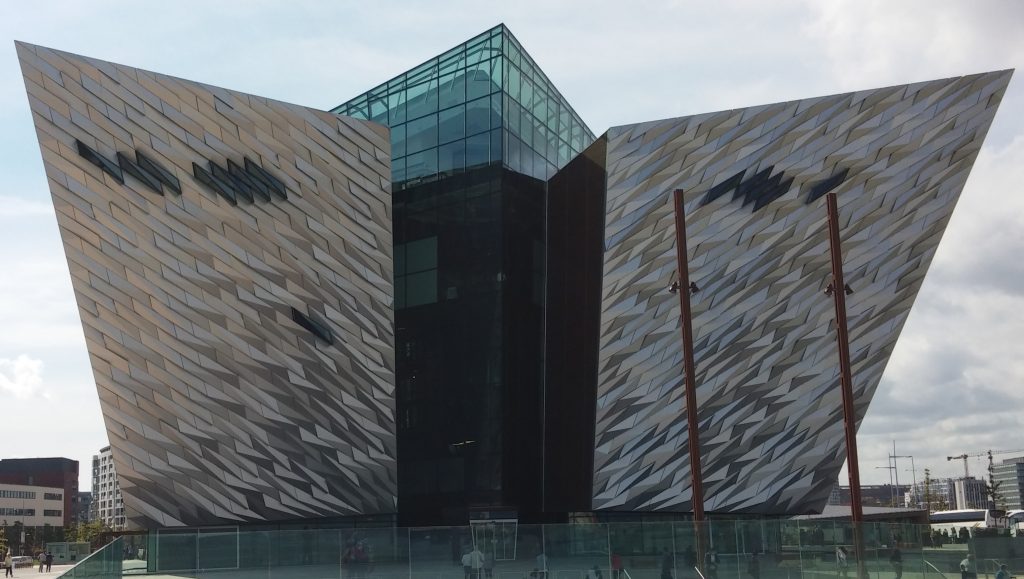
We were on the bus at 9:00 with a local guide, Ken, for a tour of Belfast. He told us that Belfast is an industrial city and made ships including the Britannic and Titanic (White Star fleet mate ships). It was also a city of inventors, such as pneumatic tires, something for tractors – the Massey Ferguson tractor was named after its inventors, mobile defibrillator, split the atom and just in the last two weeks researchers at Queens University announced a quick test to determine if a person has meningitis, taking a couple hours instead of 24. Queens University was opened in 1840 by Queen Victoria and was an ornate large building of dark brick and it now owns all the buildings around the immediate vicinity. We went to the area where there was the worst fighting and the worst time for the country in the 1970s – The Troubles. It was between the Loyalists – the Protestant Presbyterian Scots and British, and the Nationalists – the Irish Catholics. We stopped at Peace Wall, a wall blocks long with large and high boards of some kind on the wall for people to write messages of hope, or whatever, and they were pretty full. A drive down Shankill Road where most of the fighting took place had many buildings and large fences with paintings on the side of them commemorating that time period and the people involved. Northern Ireland had food during the potato famine of 1845-1852, and many people started coming in to escape the famine, bringing cholera with them. Many died from cholera rather than starvation. The streets were built over a river through part of the town as they were in two other towns, Dublin and Derry. You can’t tell if you don’t know it. We crossed over the River Lagan and saw the last White Star ship left in the world (moored in the water to our left) and then we were at the Titanic Museum, built to be at the different heights of parts of the Titanic. It was architecturally and visually beautiful to symbolize the Titanic with life boat like pieces on the sides of it. This is where Ken, our local guide left us. At the beginning of the museum tour there was a 60’ replica of a 288’ high scaffold that the workers would climb to the top each day, taking 30 minutes to go up and the same going down at the end of the day. There were some elevators, but they didn’t trust them and preferred the climb. We got into some two bench gondola type enclosed seat with open top that had an arm that took us up, down, sideways and turned past very large visuals that explained about how the Titanic was built. We ended at the top floor (what we would call the 5th floor) where we got off and toured at our own pace each floor going down to the first floor, or further down to the ground floor. There were small replicas of the ship, real size replicas of first class special stateroom, regular first class and second class rooms, pictures, maps, history and the ship messages between the Titanic and others. There was also a graphic of how the ship sank in real time and it was surprising how fast it went down. A room with video of divers looking at the sunken ship and artifacts that were found had a glass floor that made you feel like you were in water. We were able to eat lunch at a café there and we had time to go outside to photograph the building.
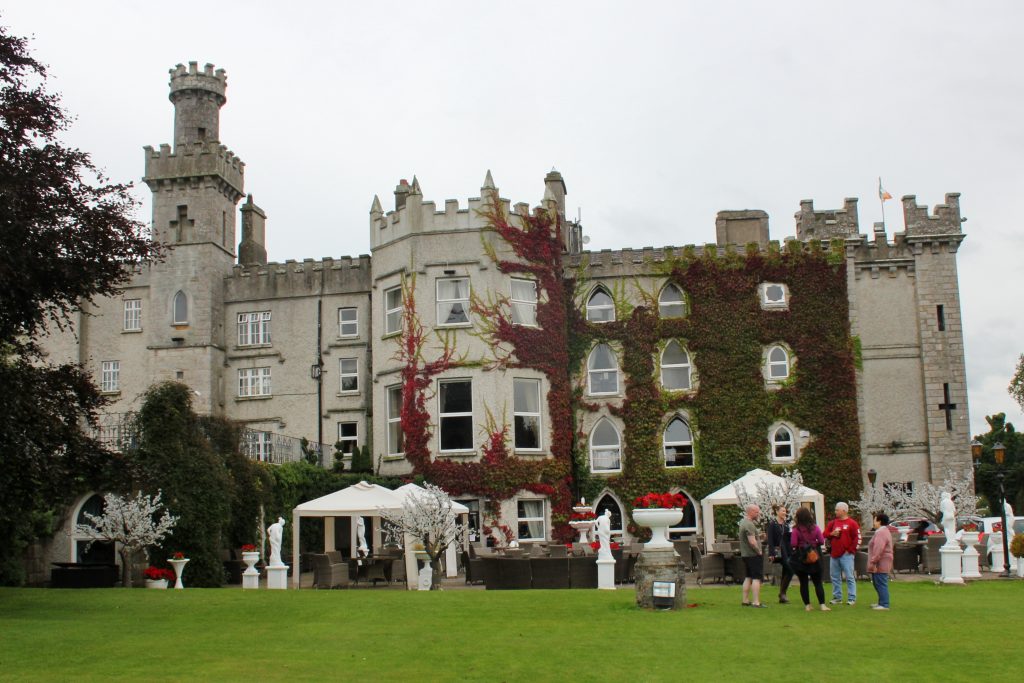
We drove south, crossing back into the Republic of Ireland on our way to Kingscourt and Cabra Castle, our last night’s lodging. It was very large and very impressive. Our guest rooms were in two story rows of buildings behind the castle that perhaps had been quarters of workers long ago. The rooms, opened with skeleton keys, have been refurbished and furnished with lovely antique pieces. There was also a wedding going on that evening in another part of the castle so we periodically saw guests dressed very fancy for that, with women in hats. We had time to wander around the beautiful castle and grounds before we had our farewell dinner in the third floor Gallerie room. John had told us earlier we had been his best group and we thought he probably told all his groups that. At dinner he told me privately that we really were his best group because we all just melded together and got along very well, plus we were fun. (We always have had a great group for our travel.) After dinner several of us gathered under a covering on the terrace for drinks and talk, then back to our rooms to get ready for departure the next morning.
Even though we had been in Ireland for eleven days, nearly all of us would have liked to stay a few more days. It was that great! The next morning we were taken to the Dublin airport, having made a complete circle around the island, we started our journey home with memories of a wonderful experience.




